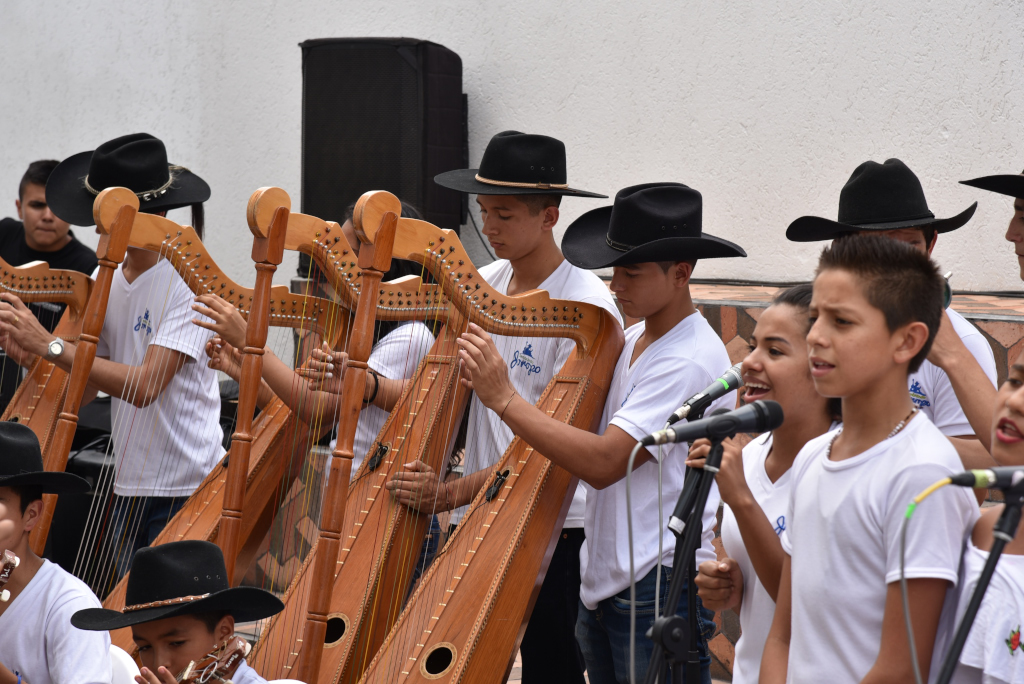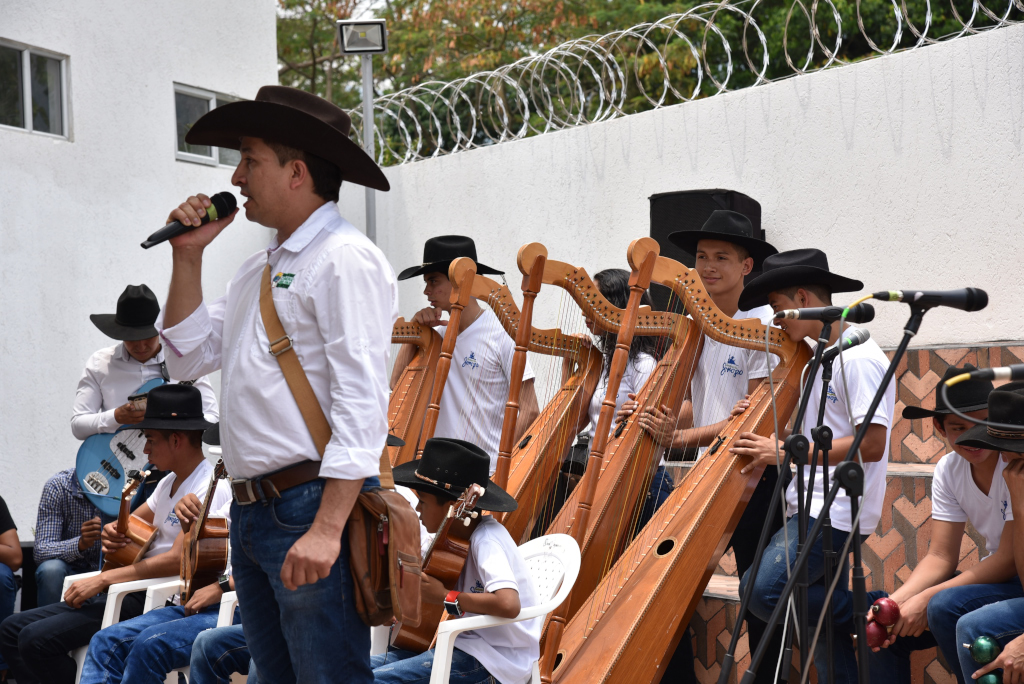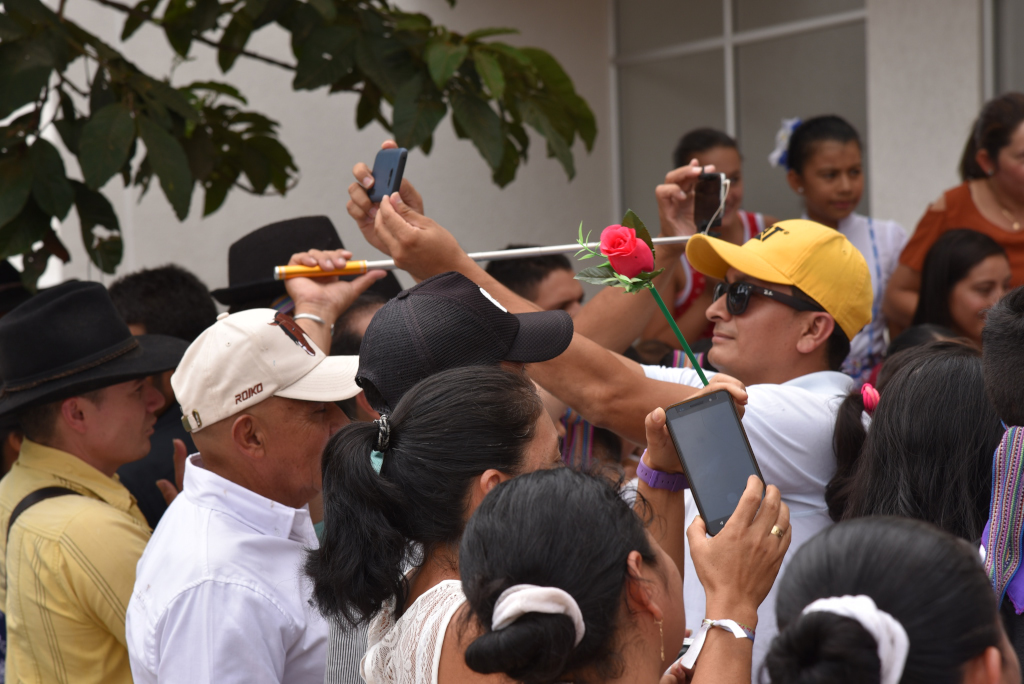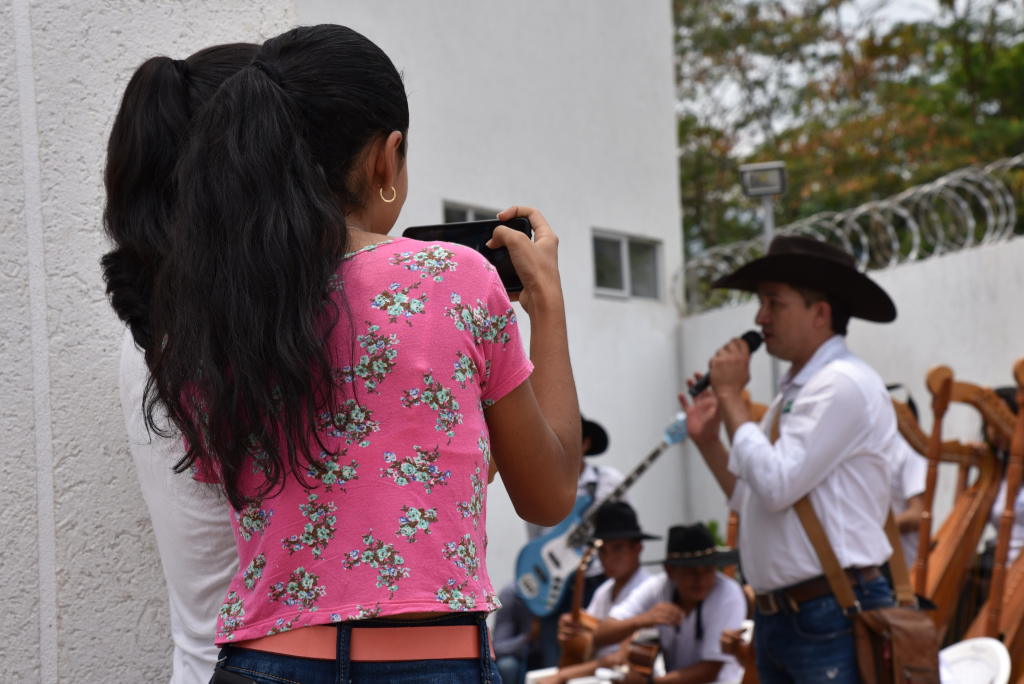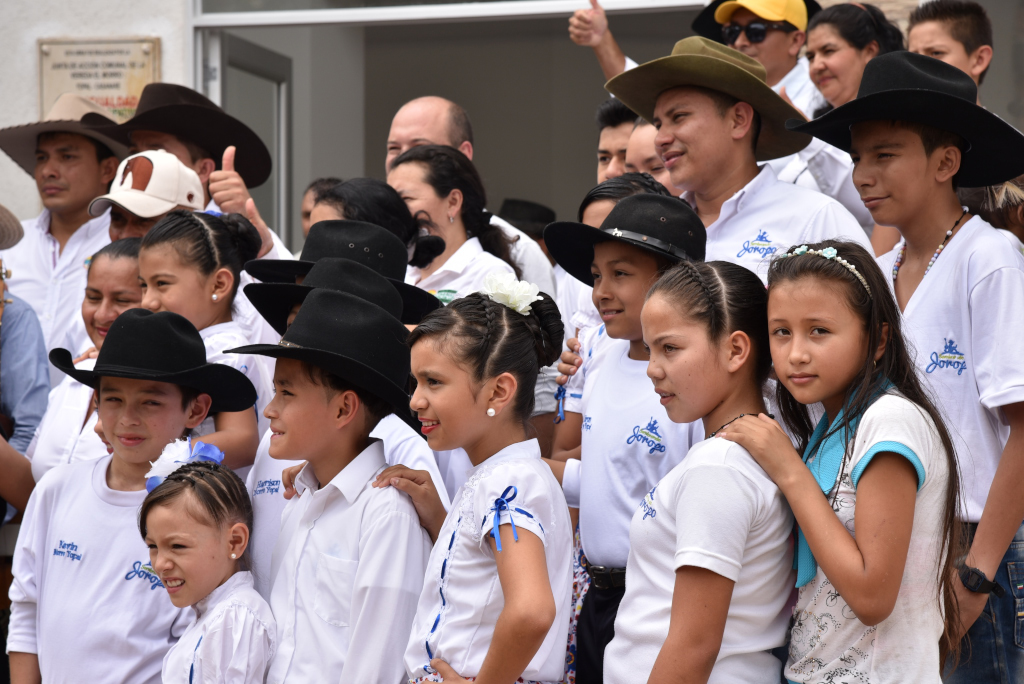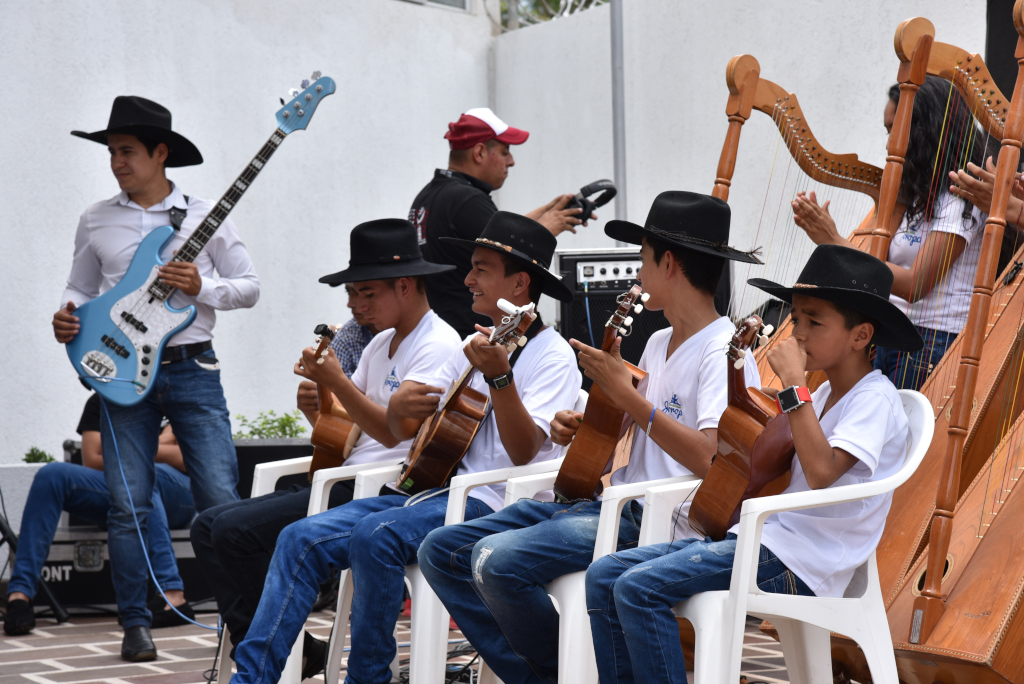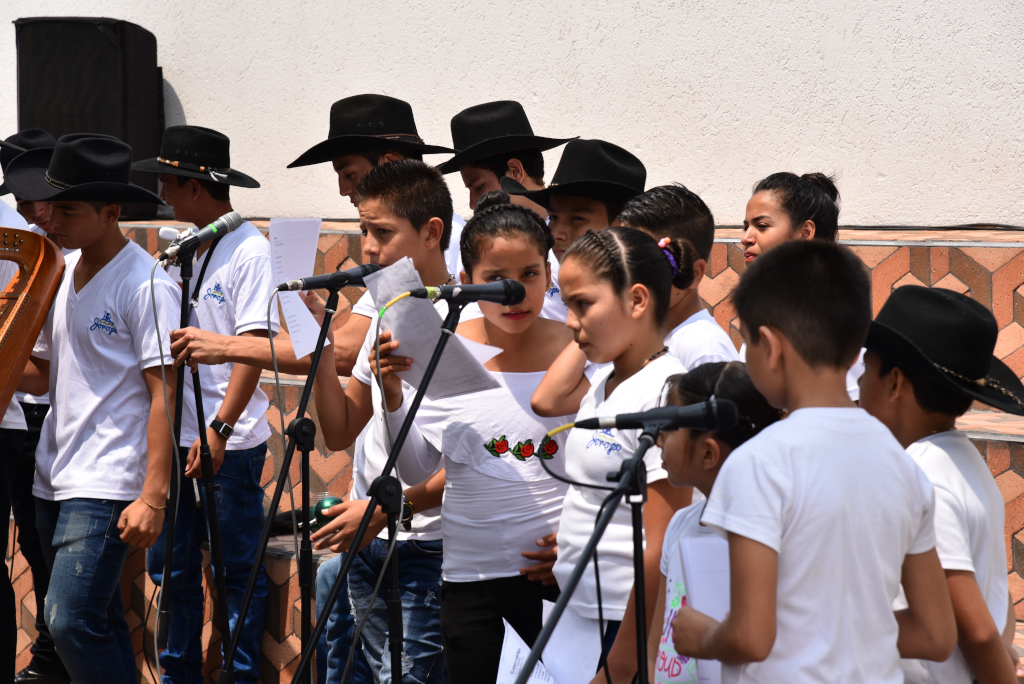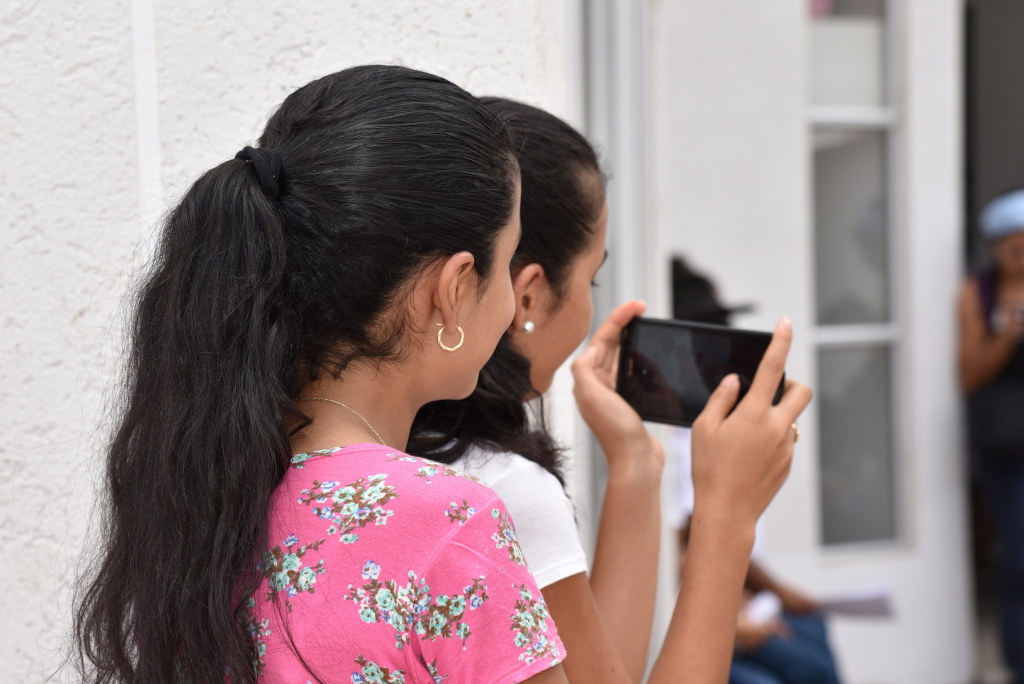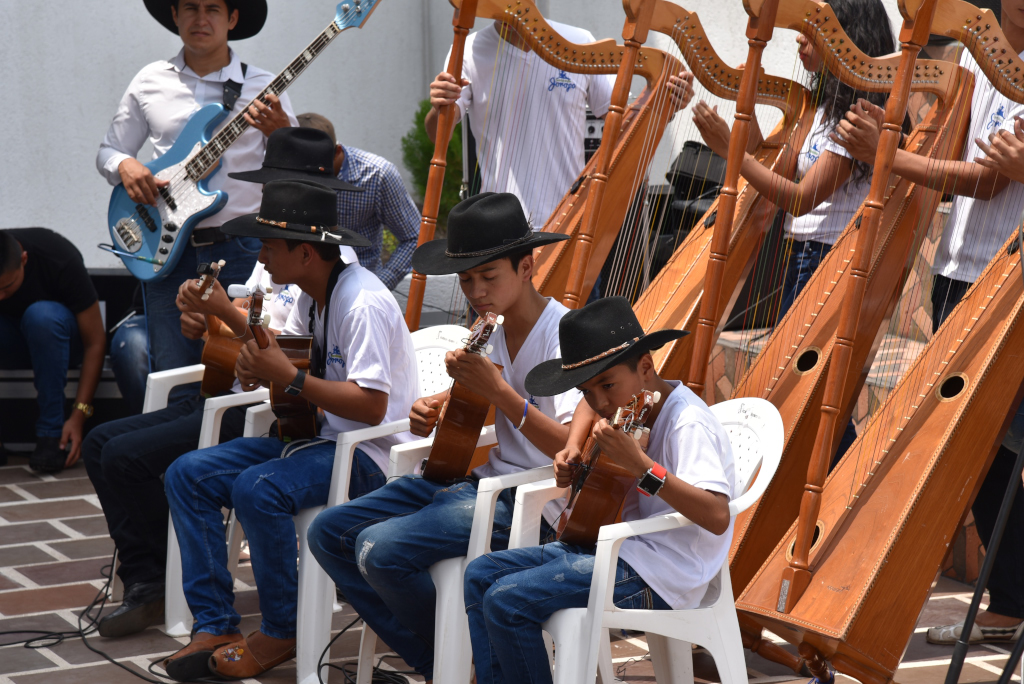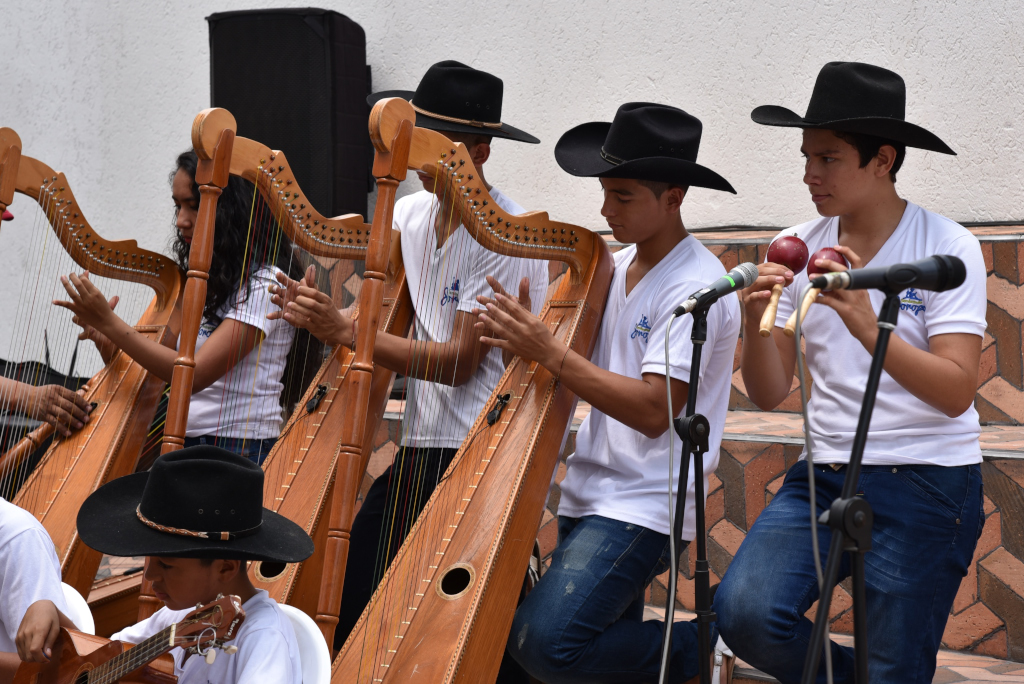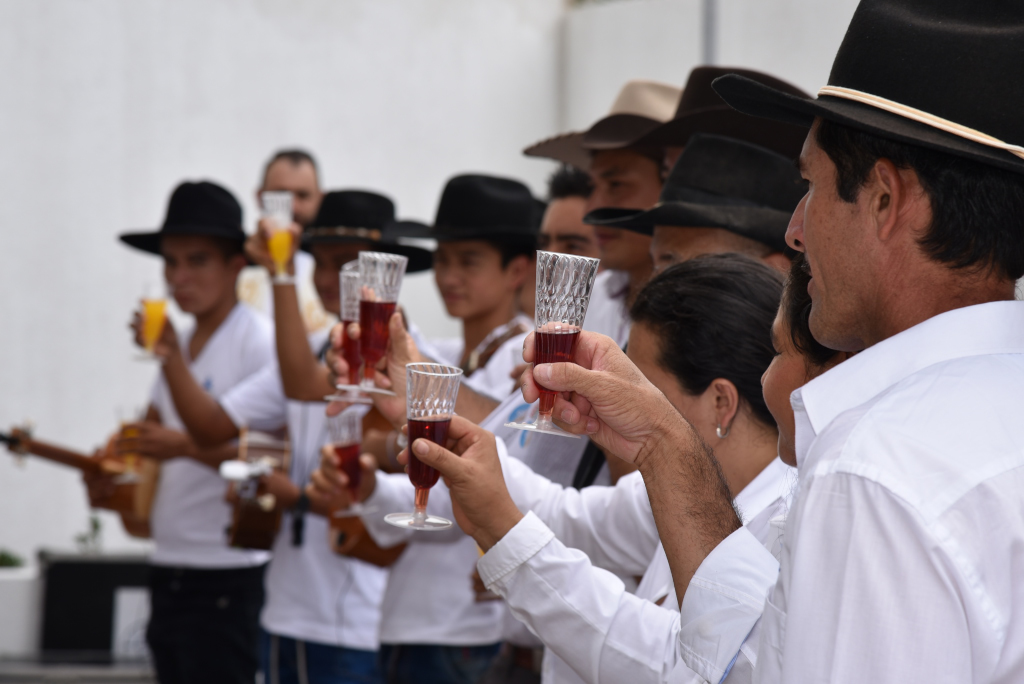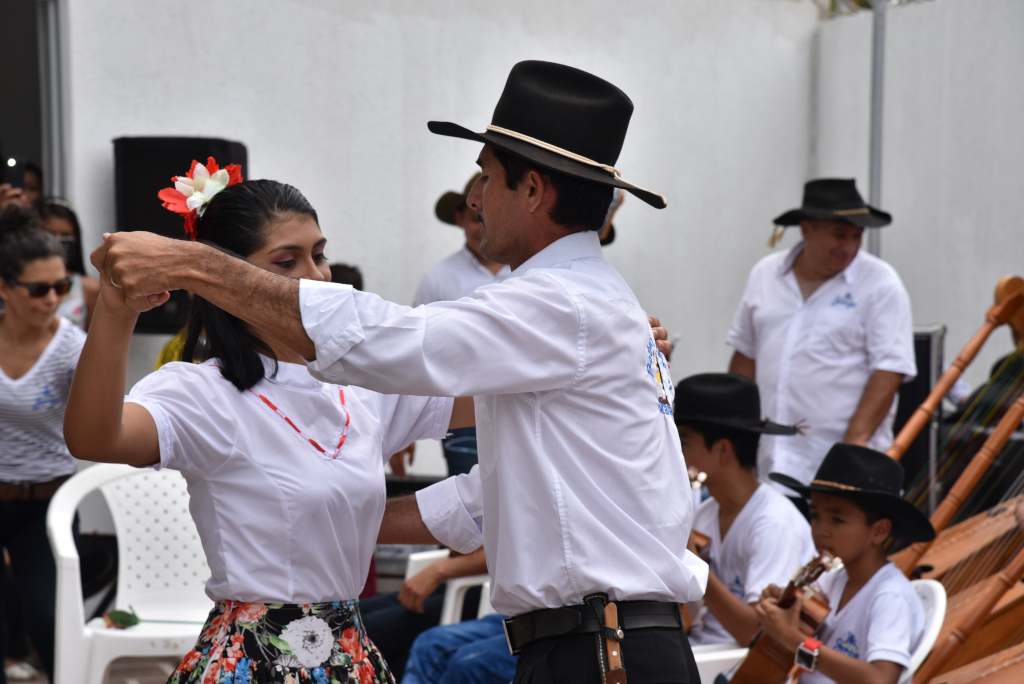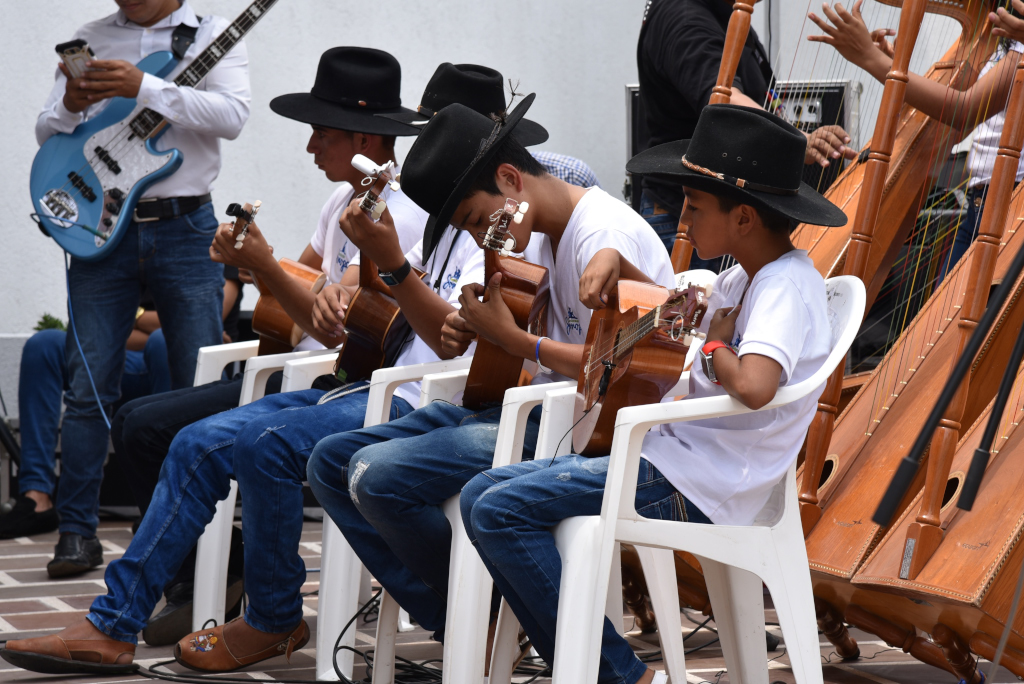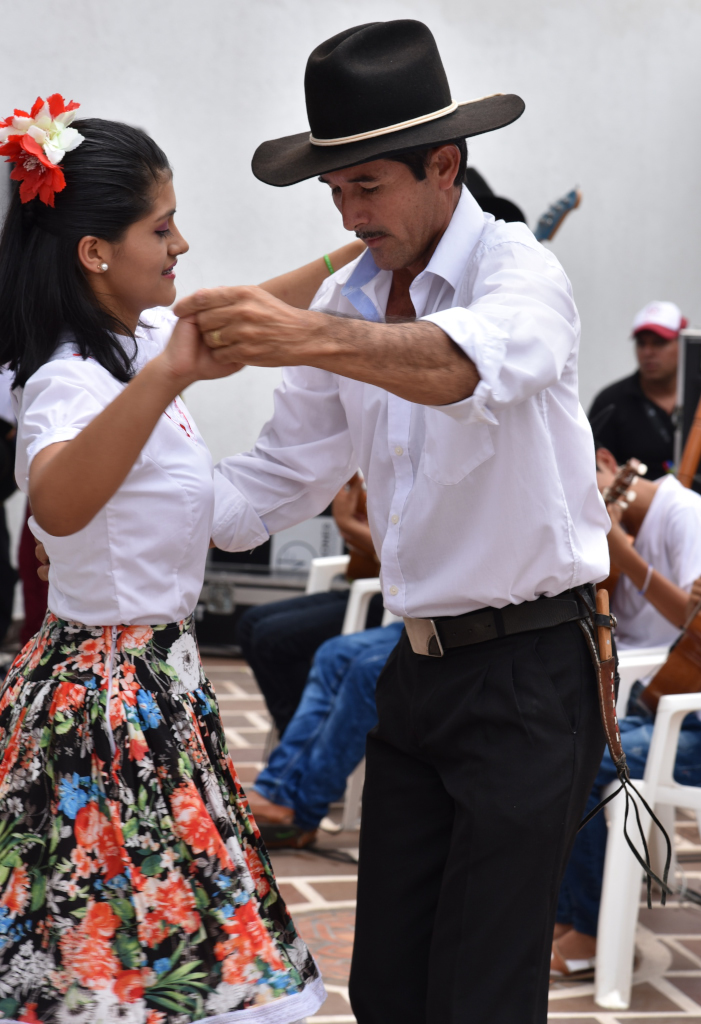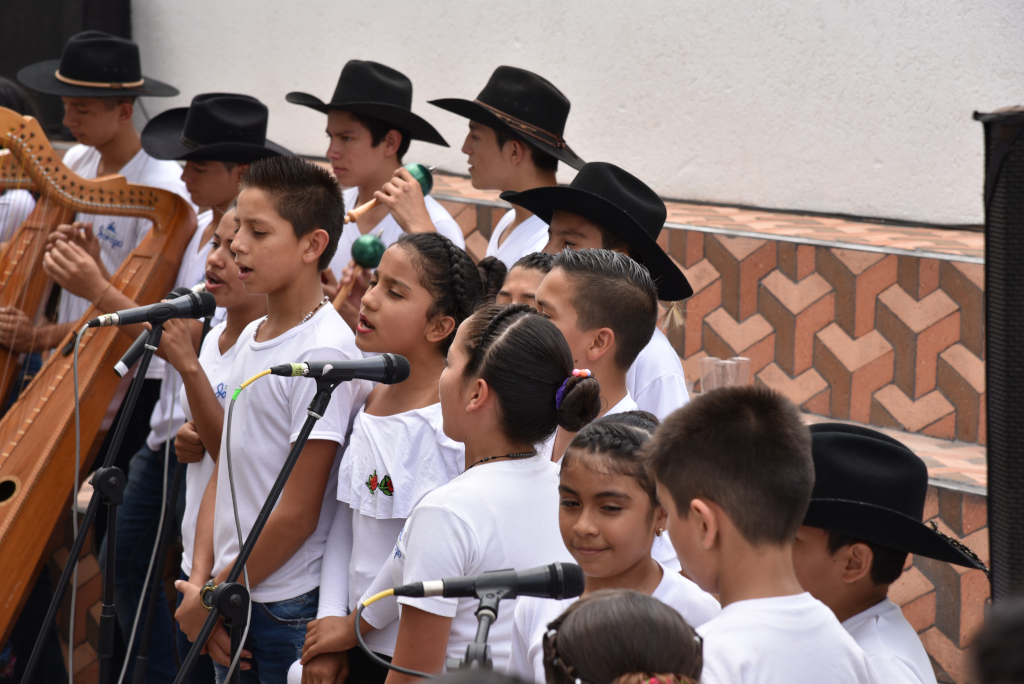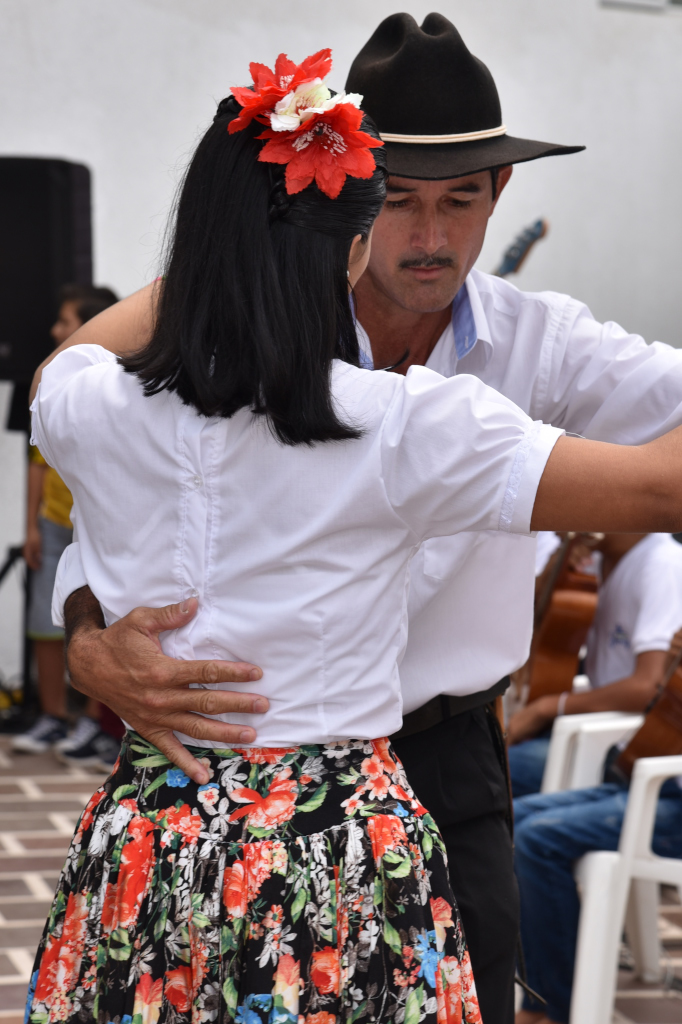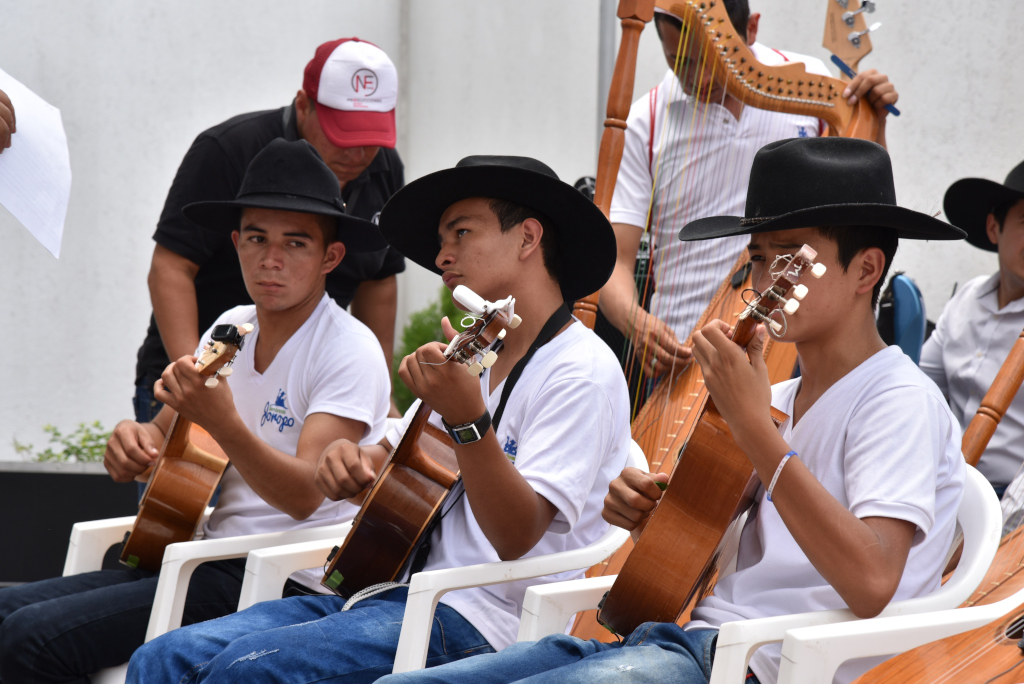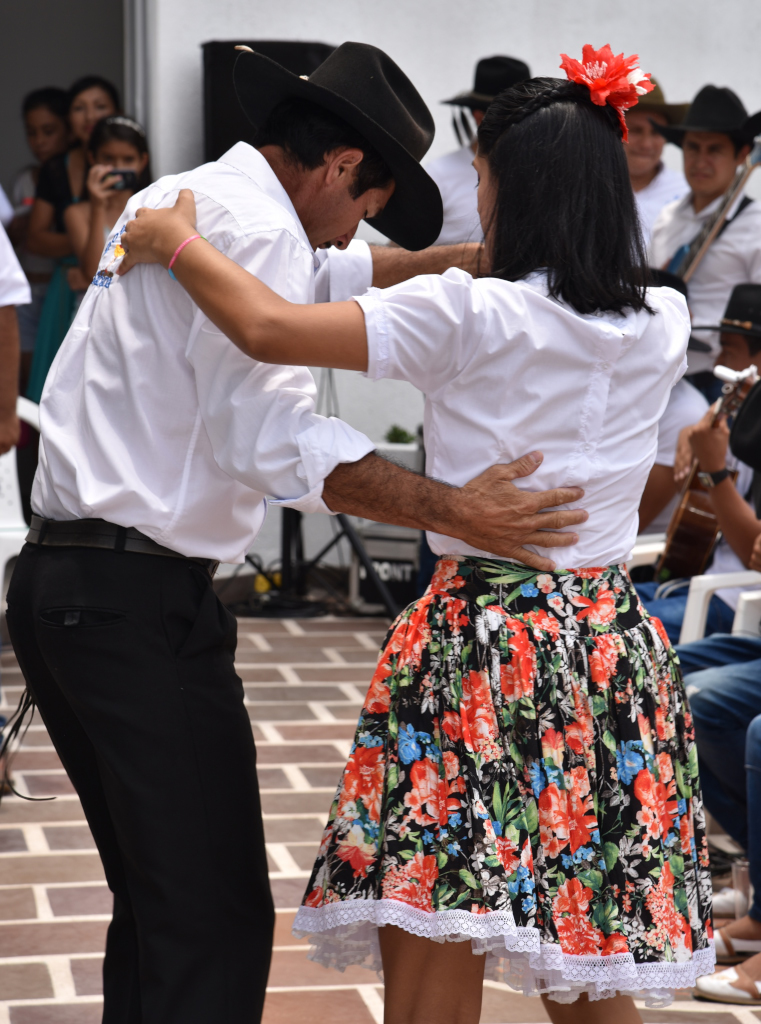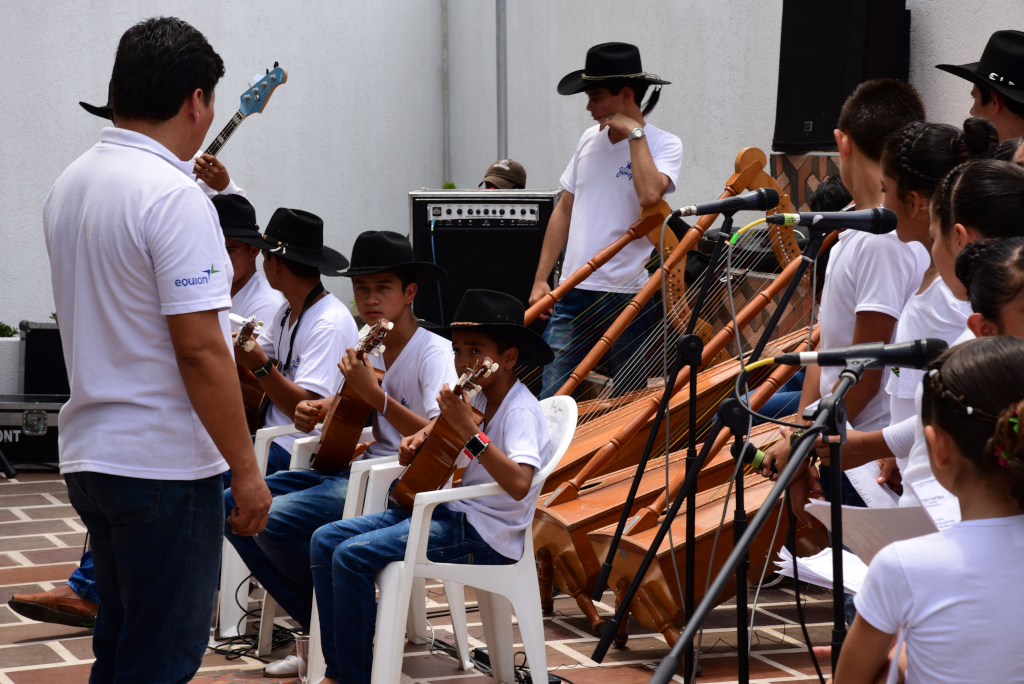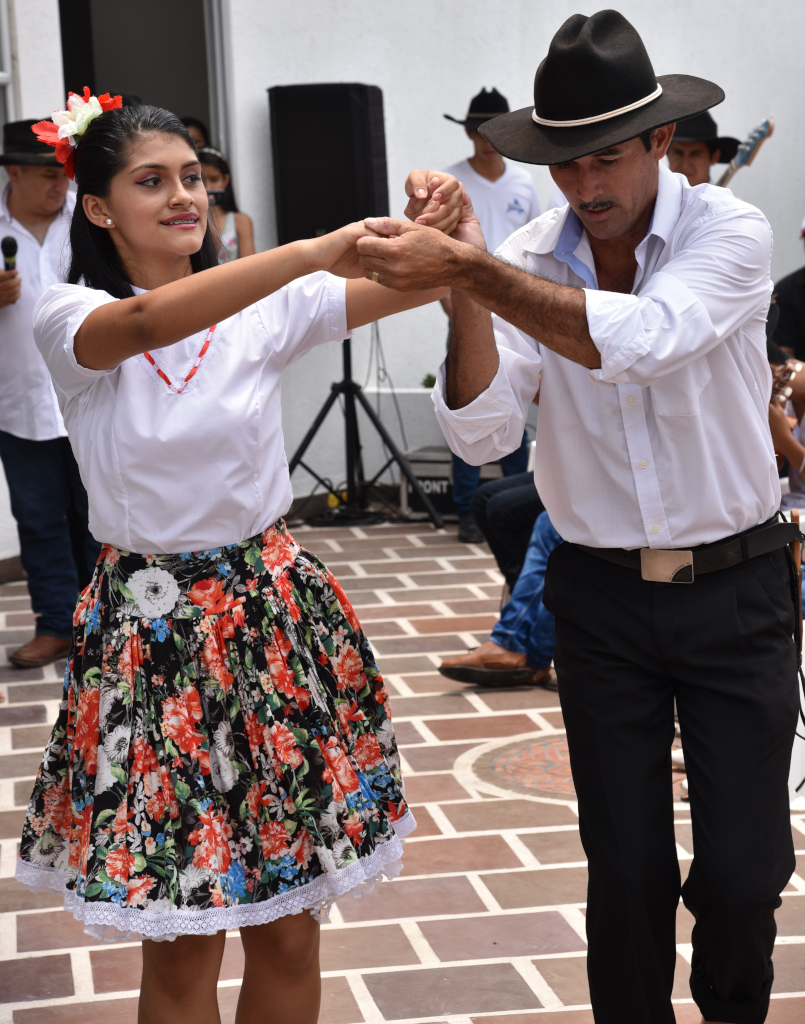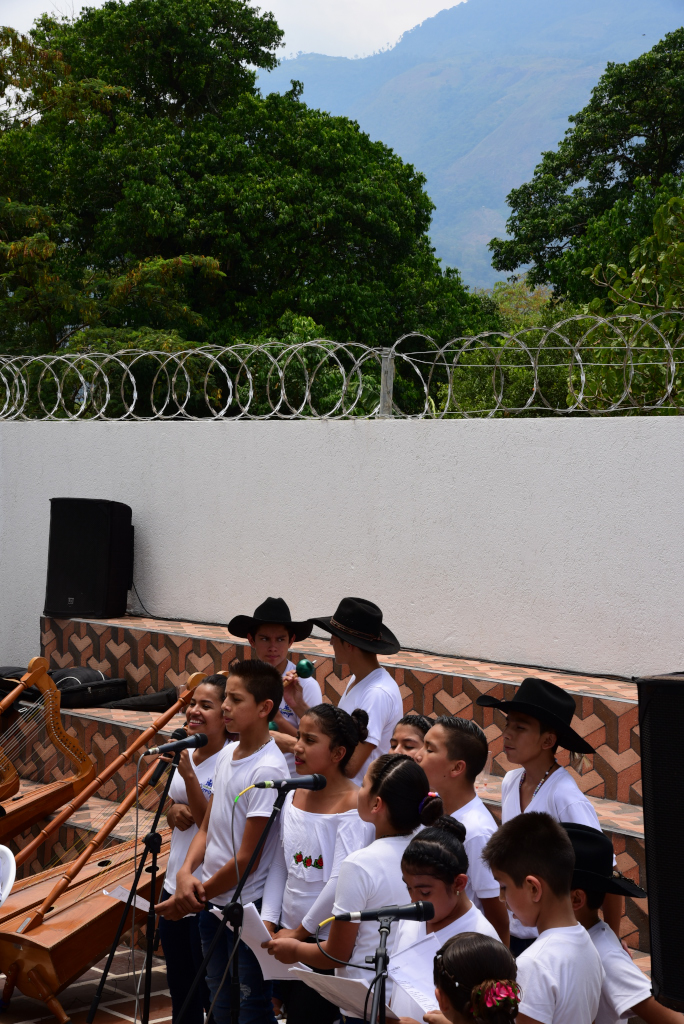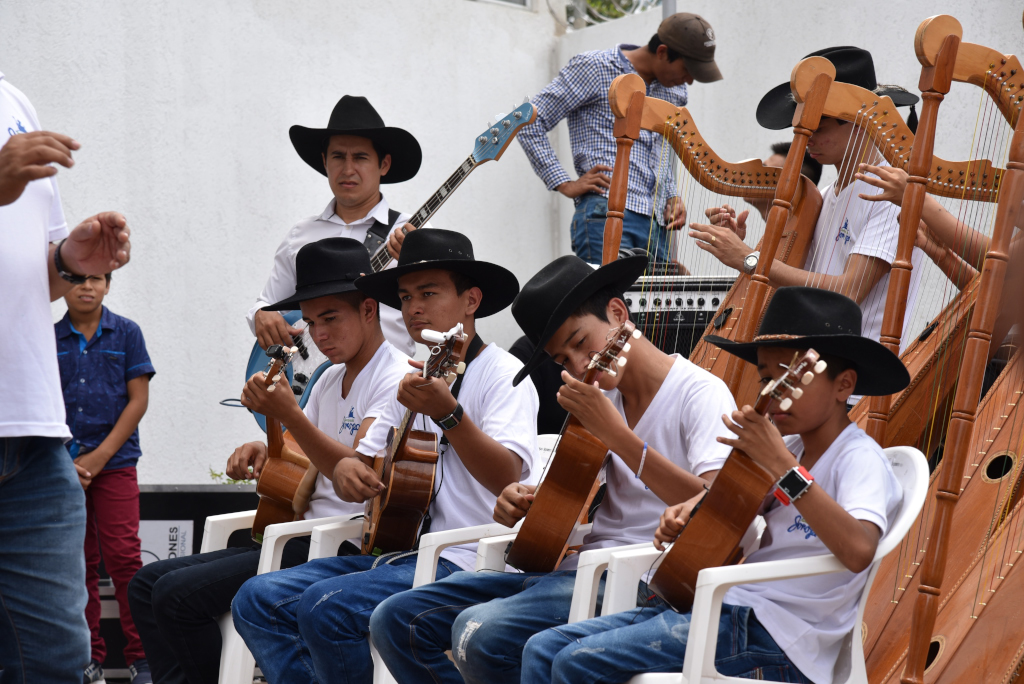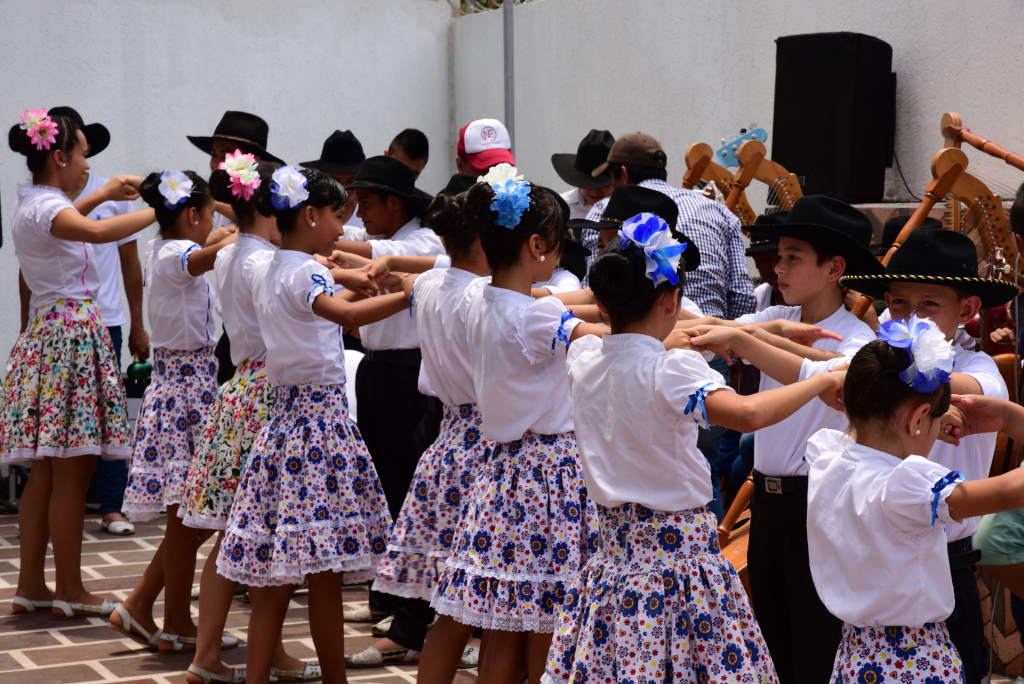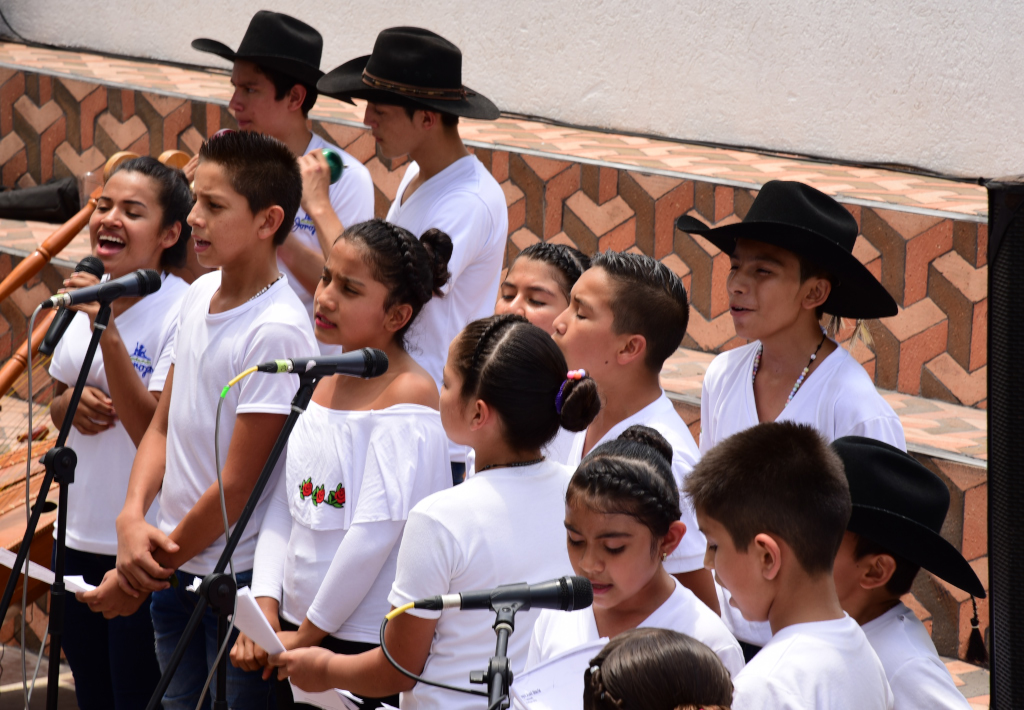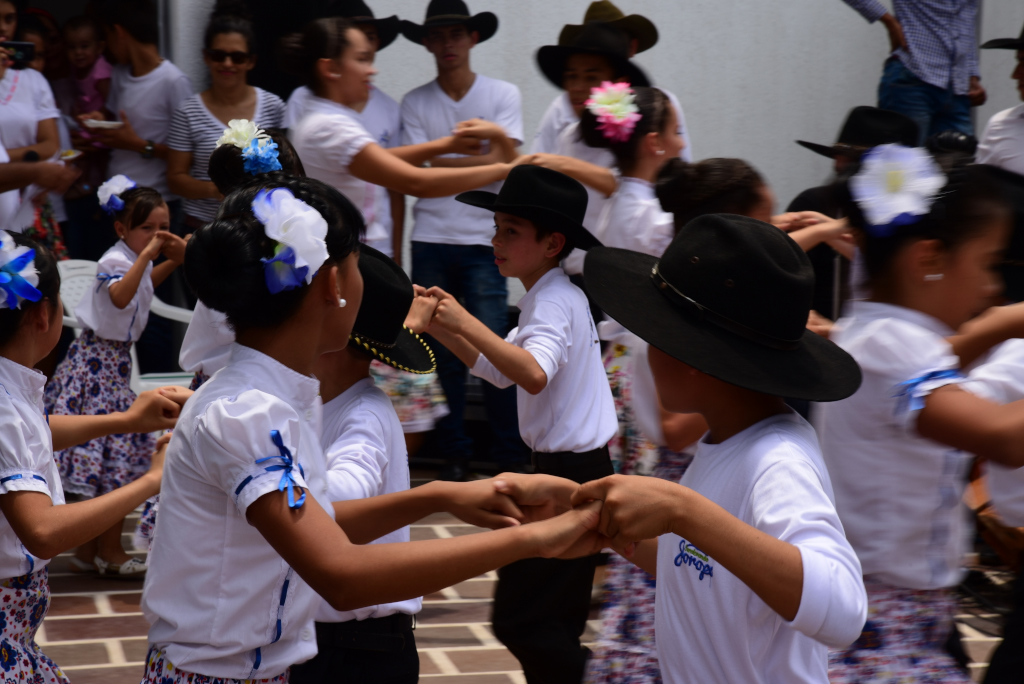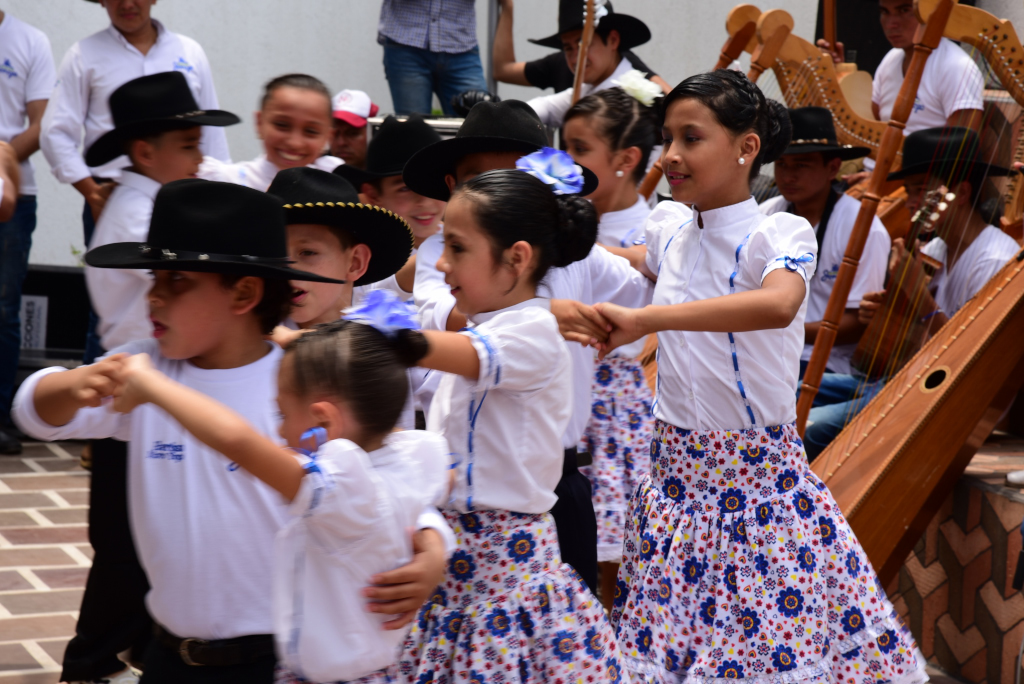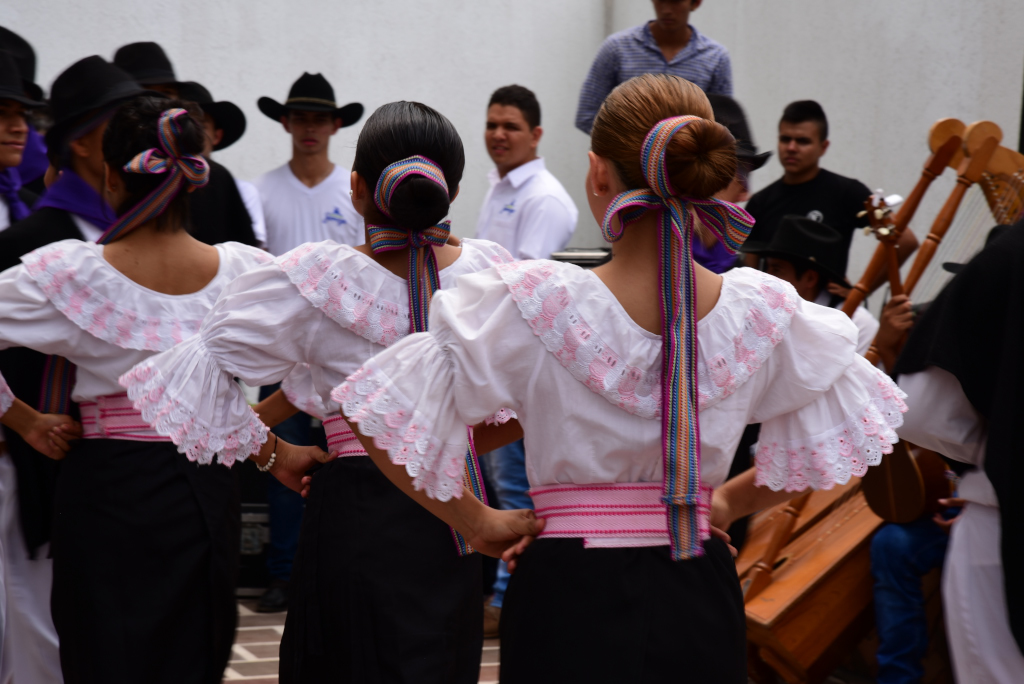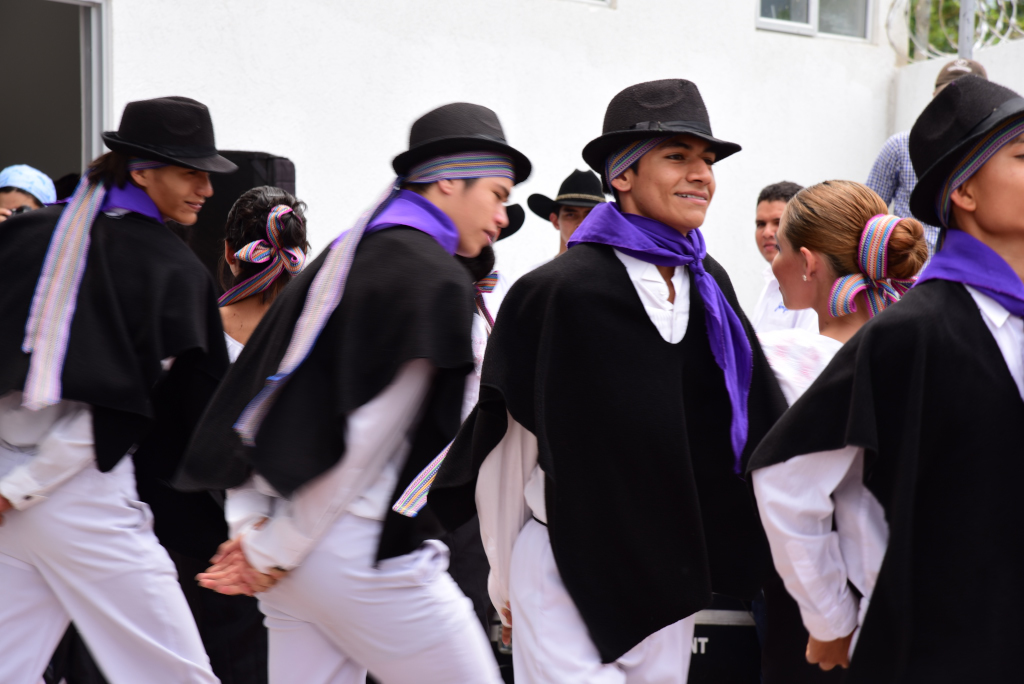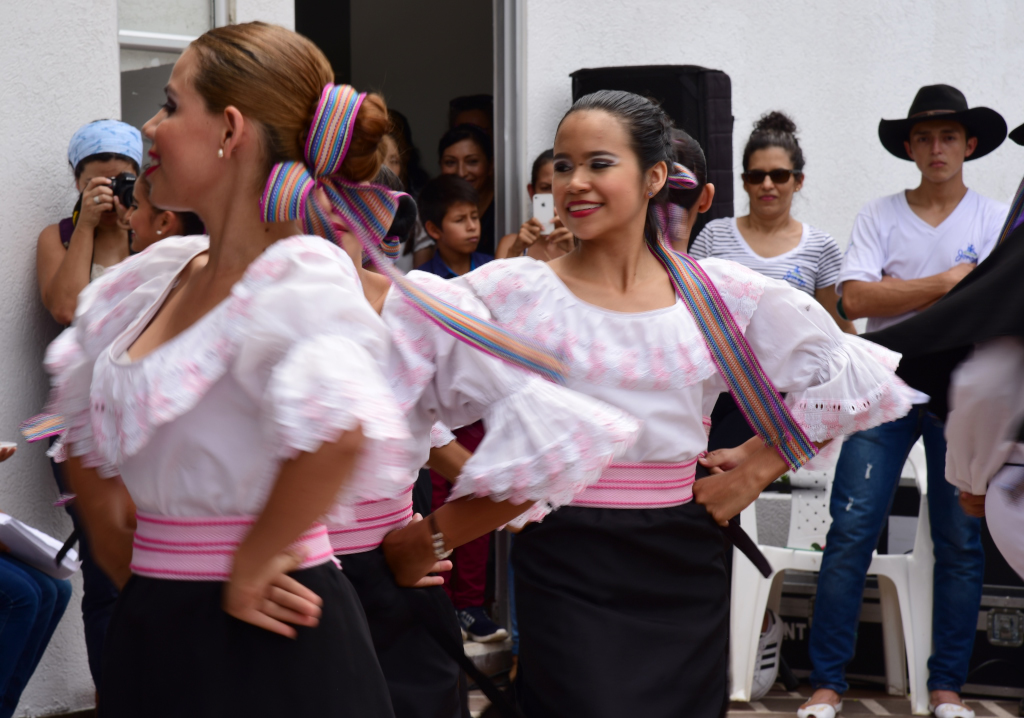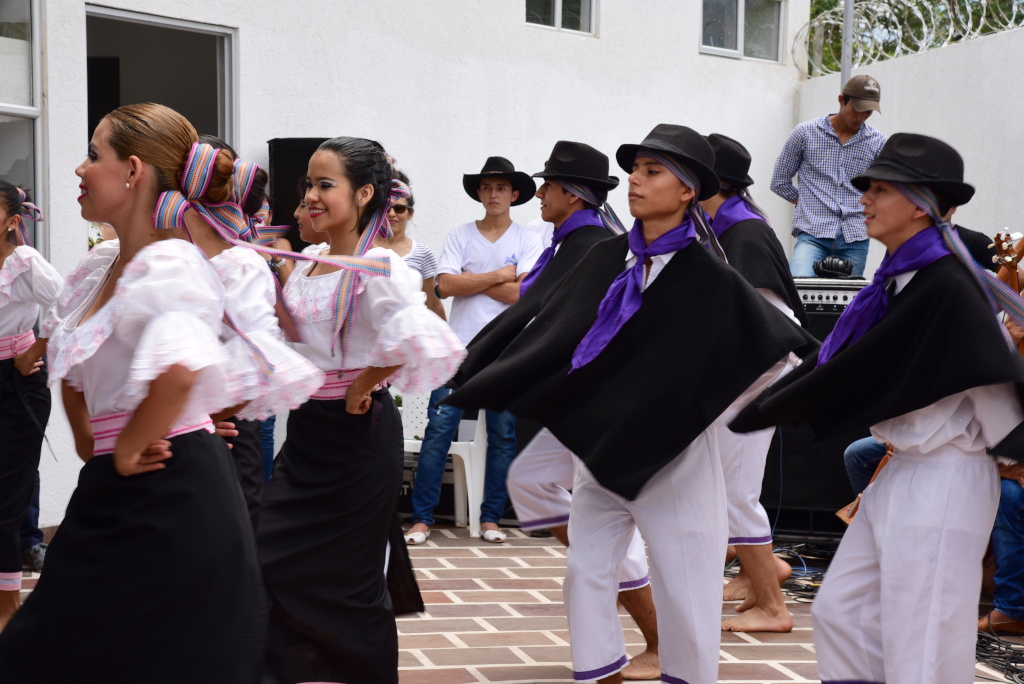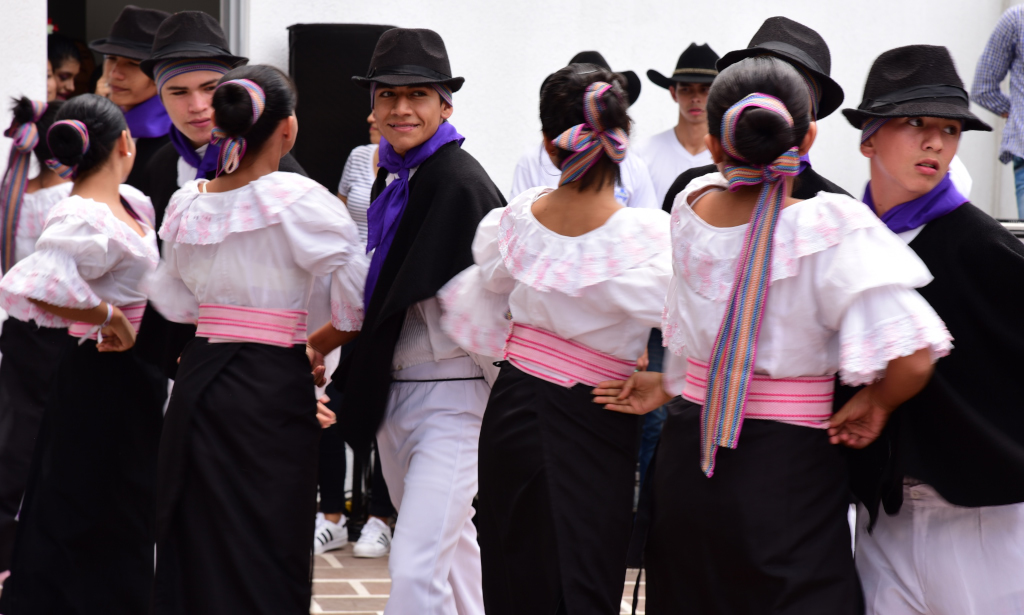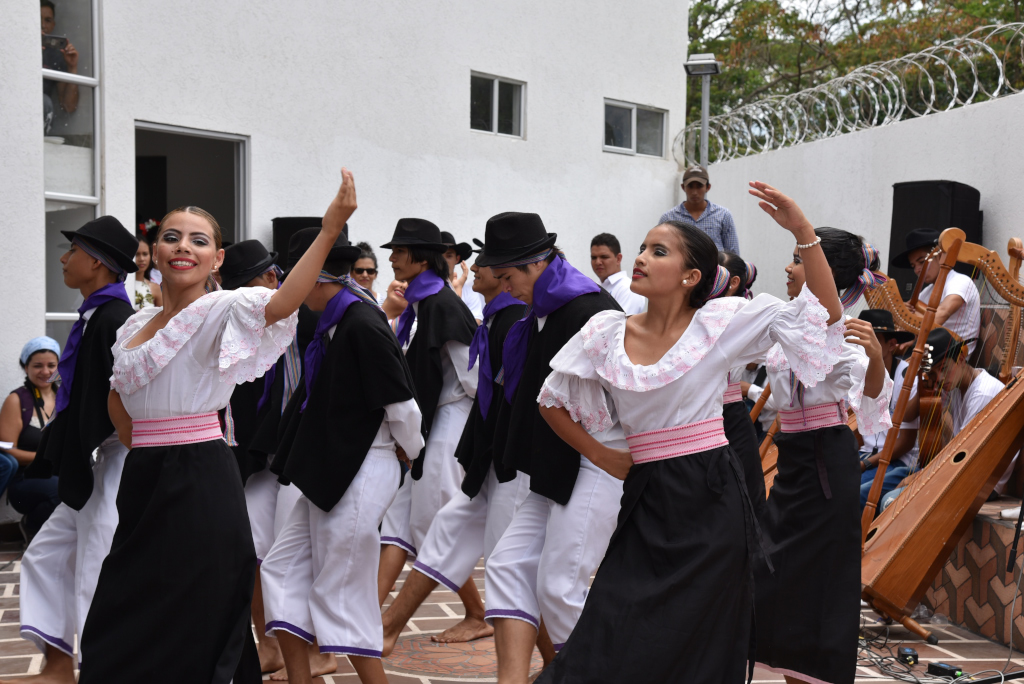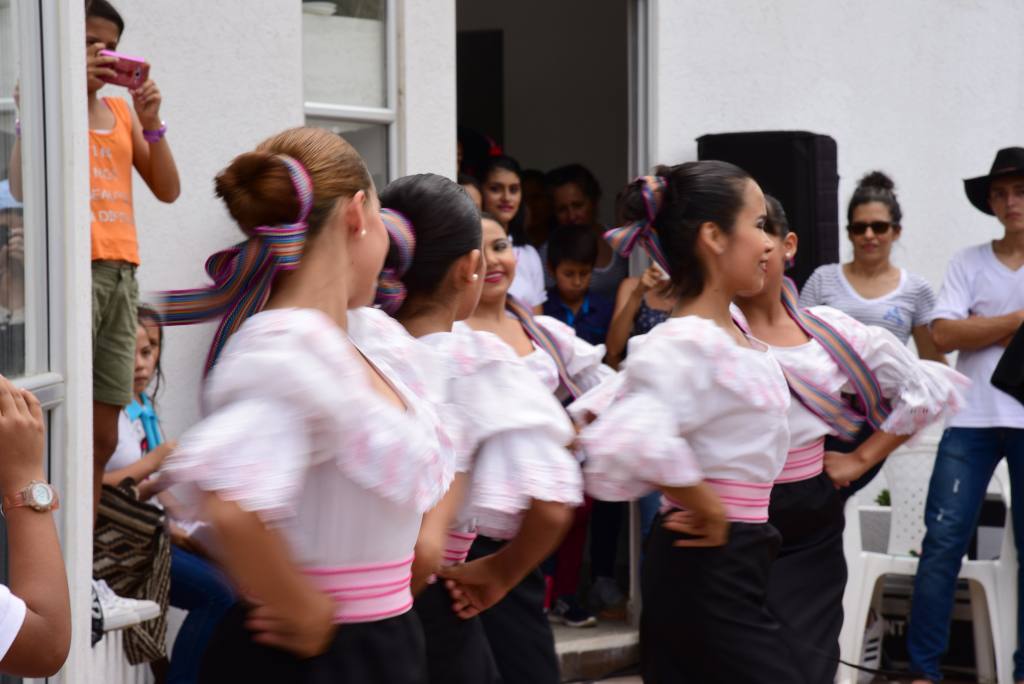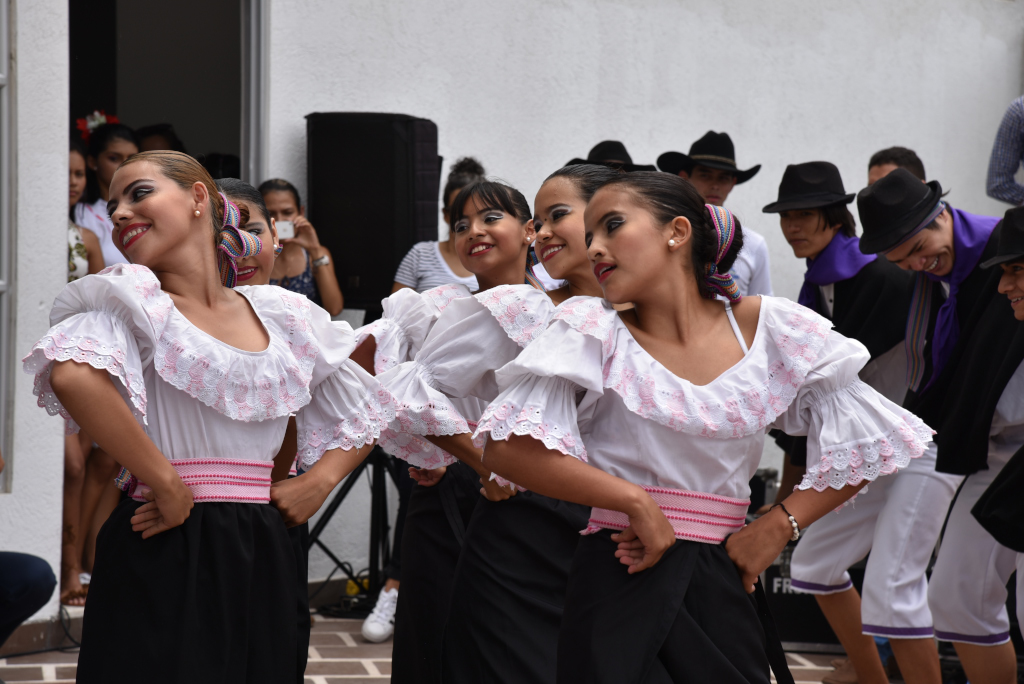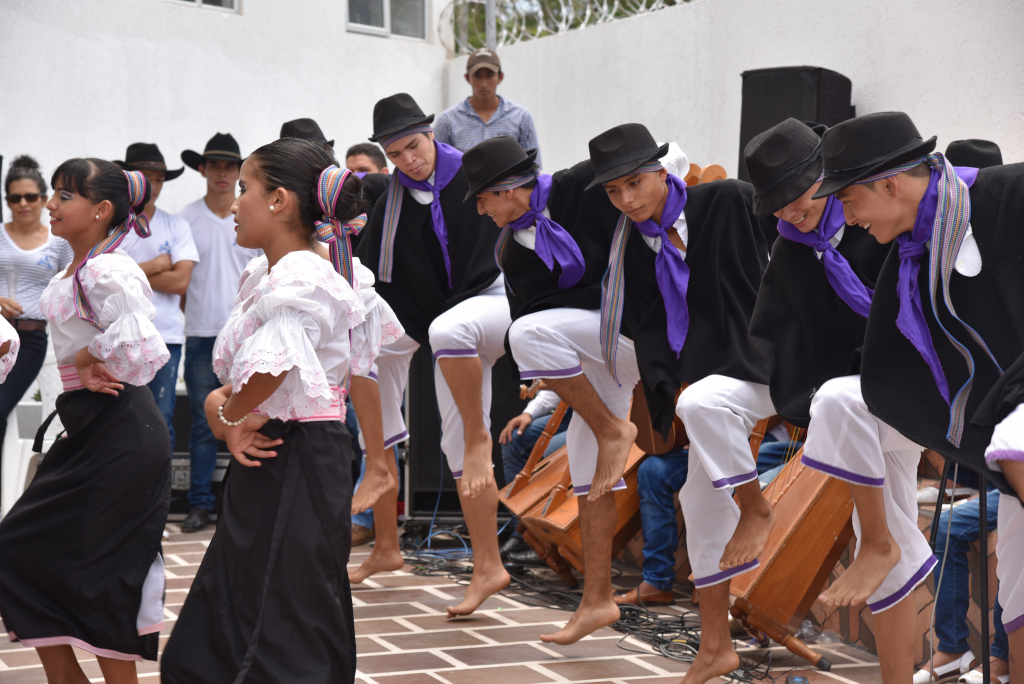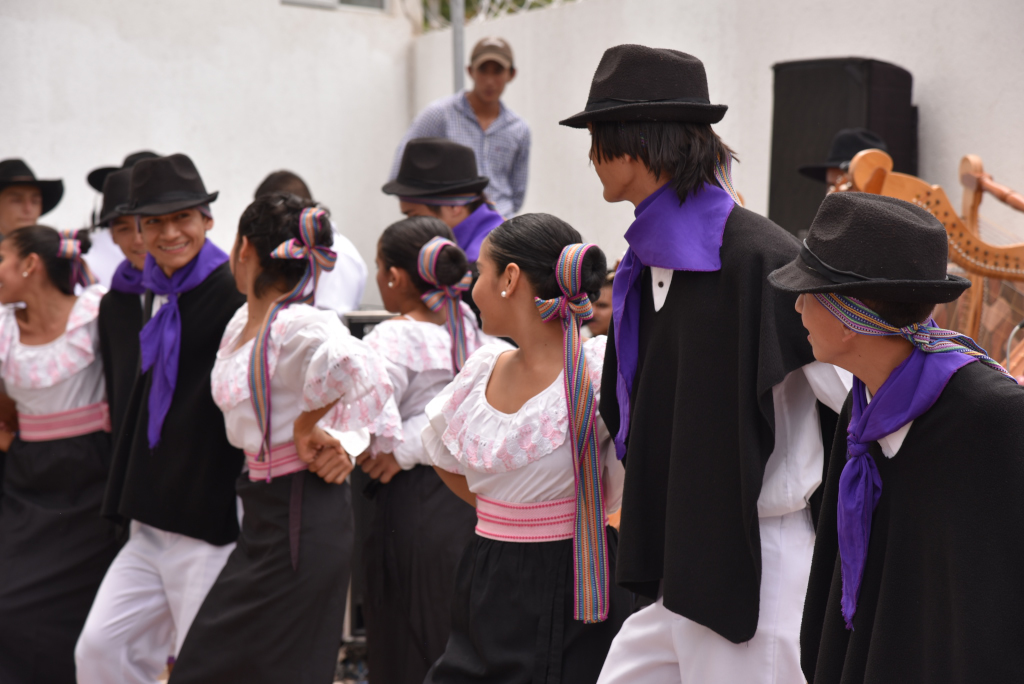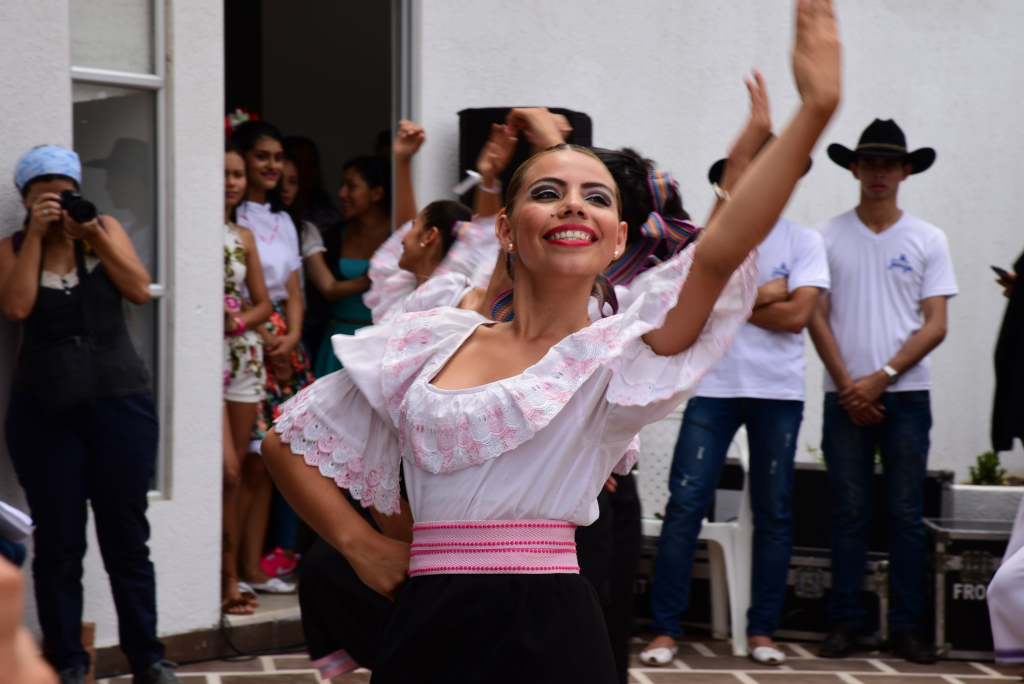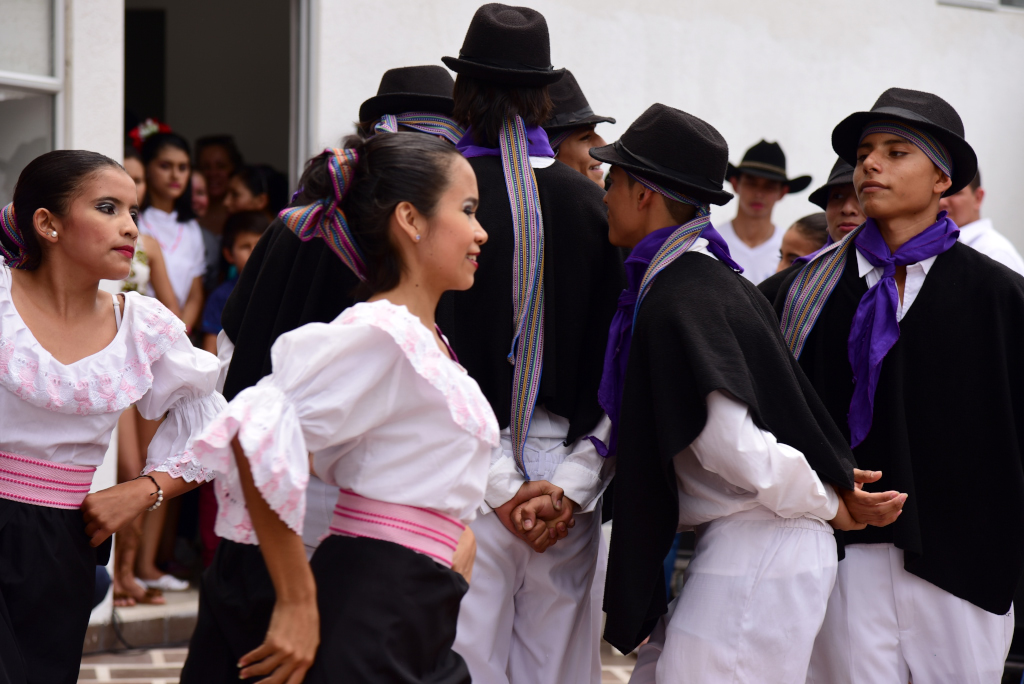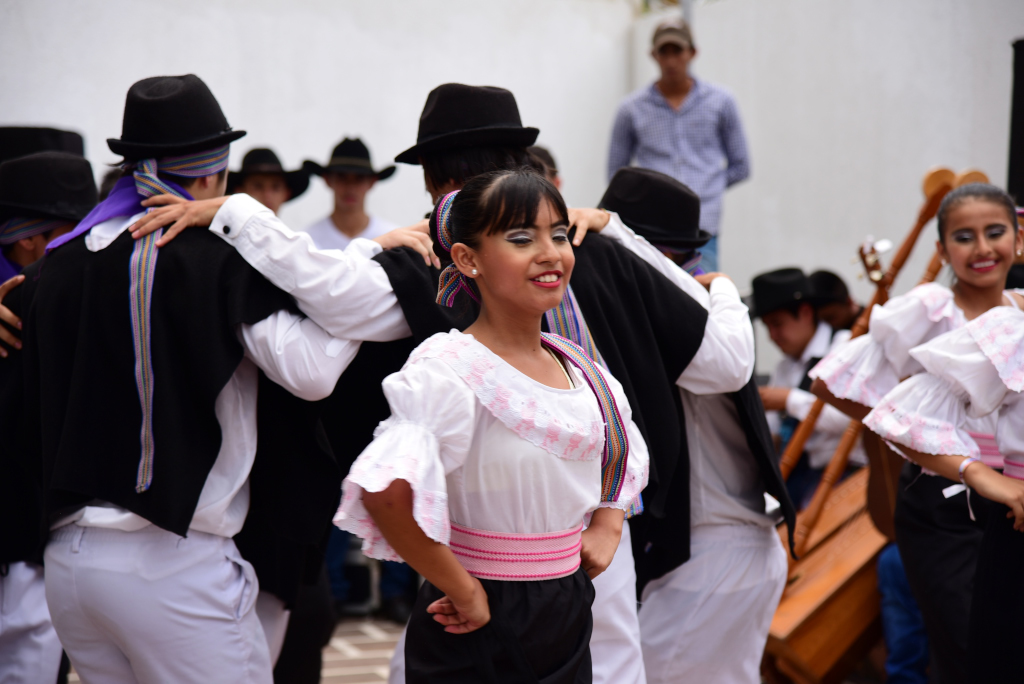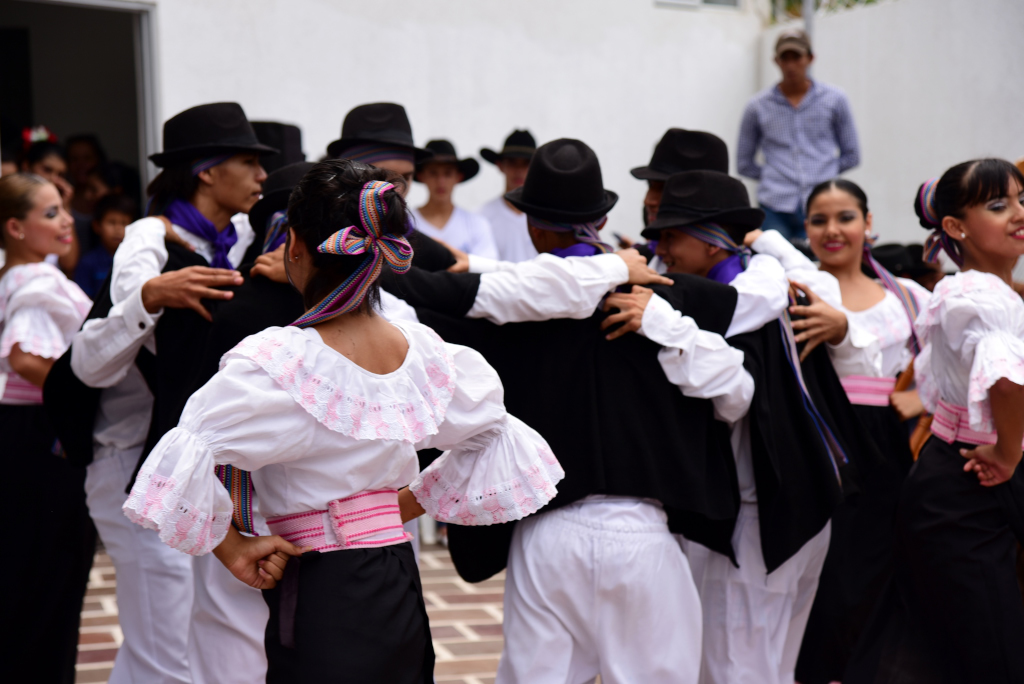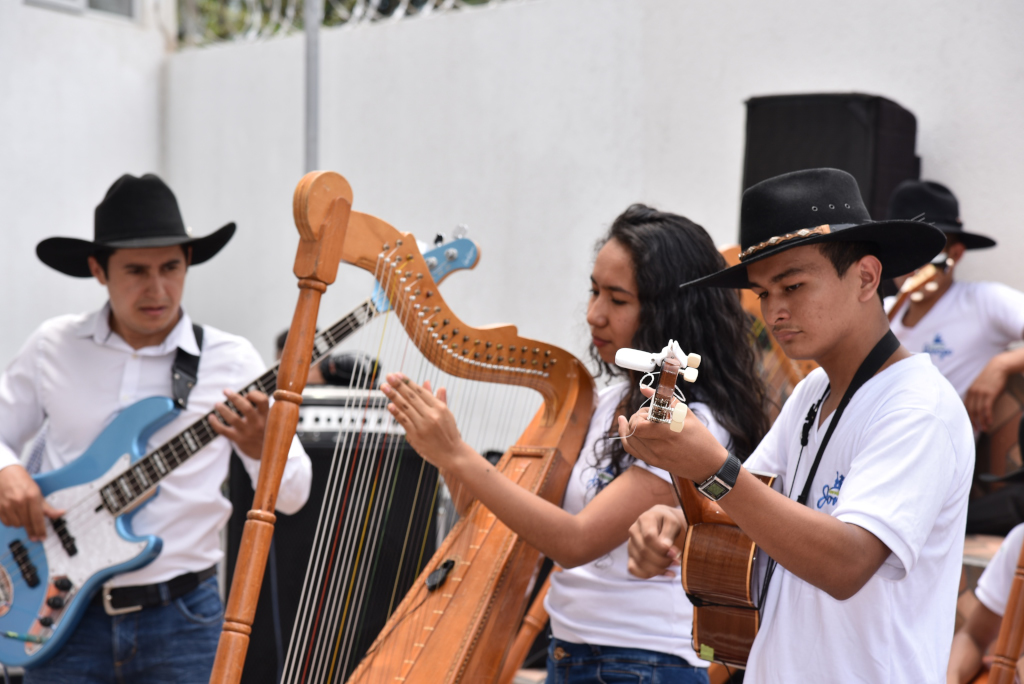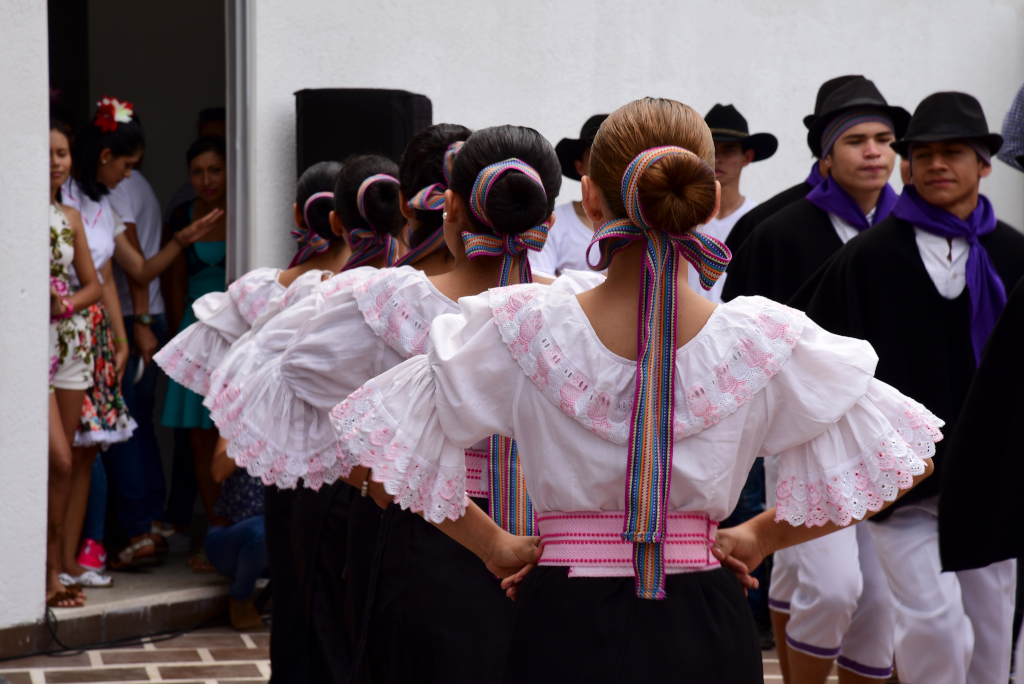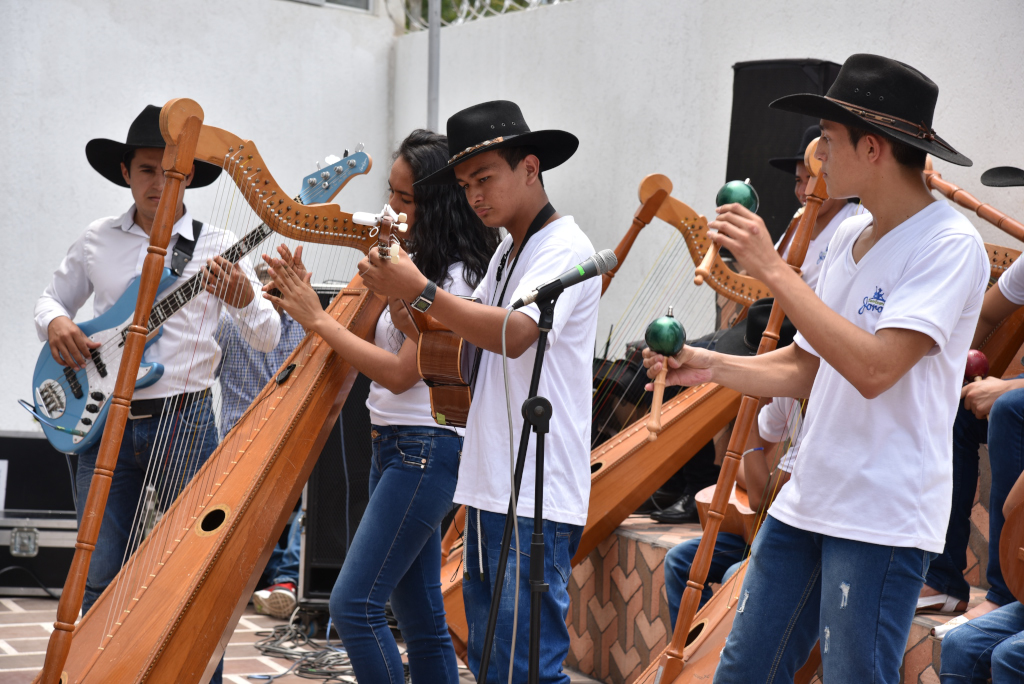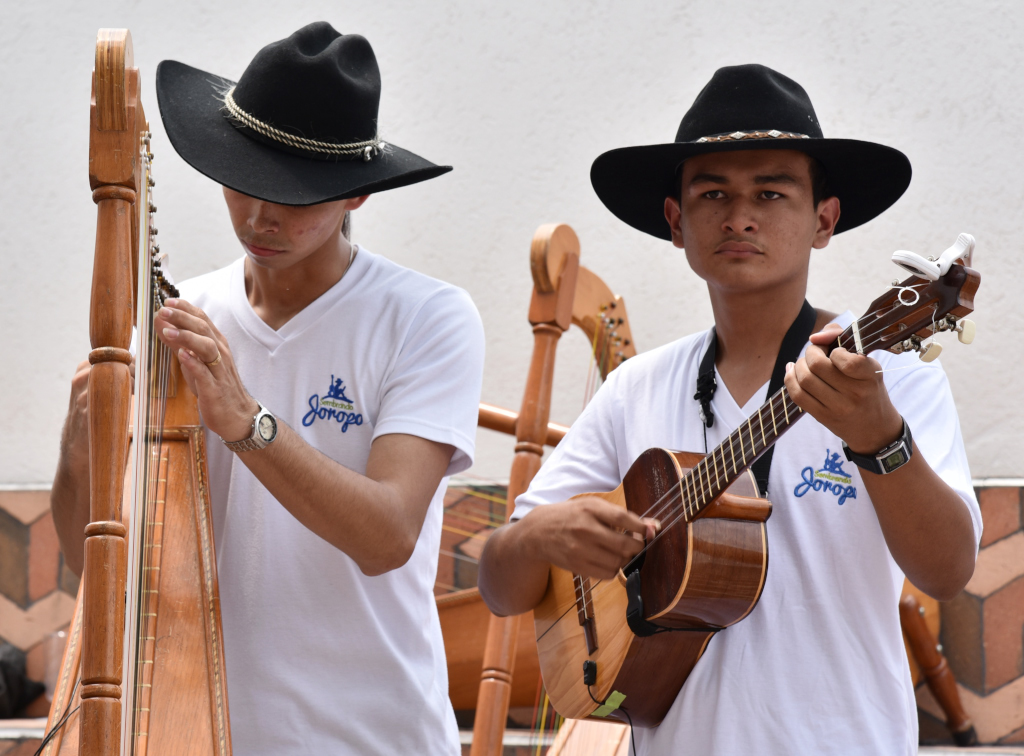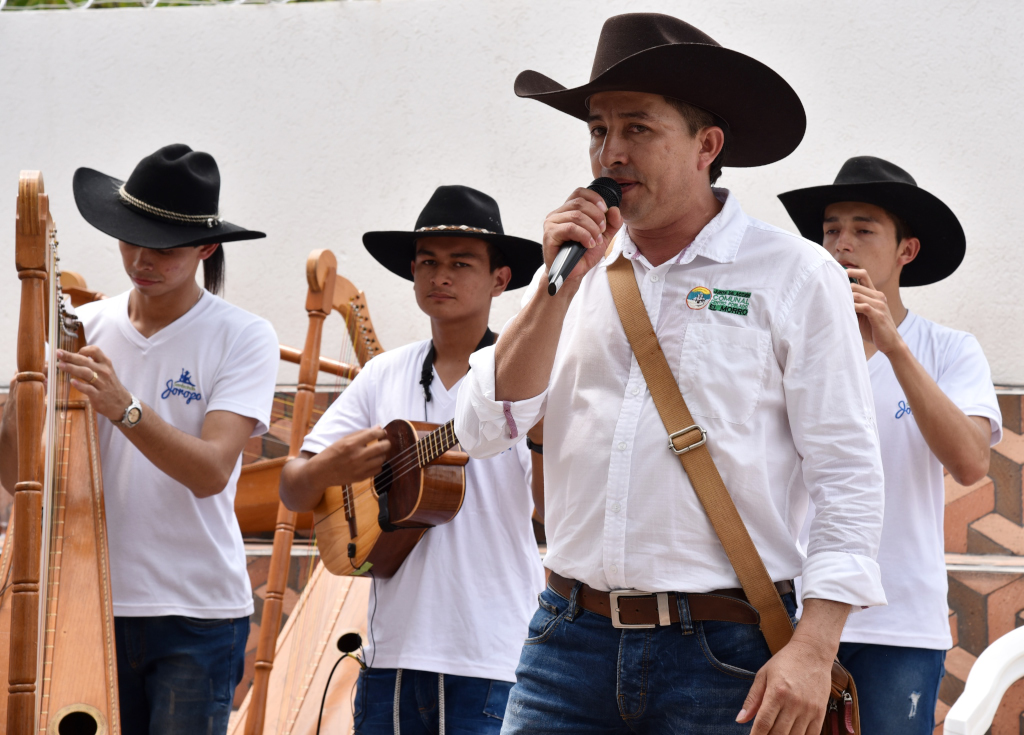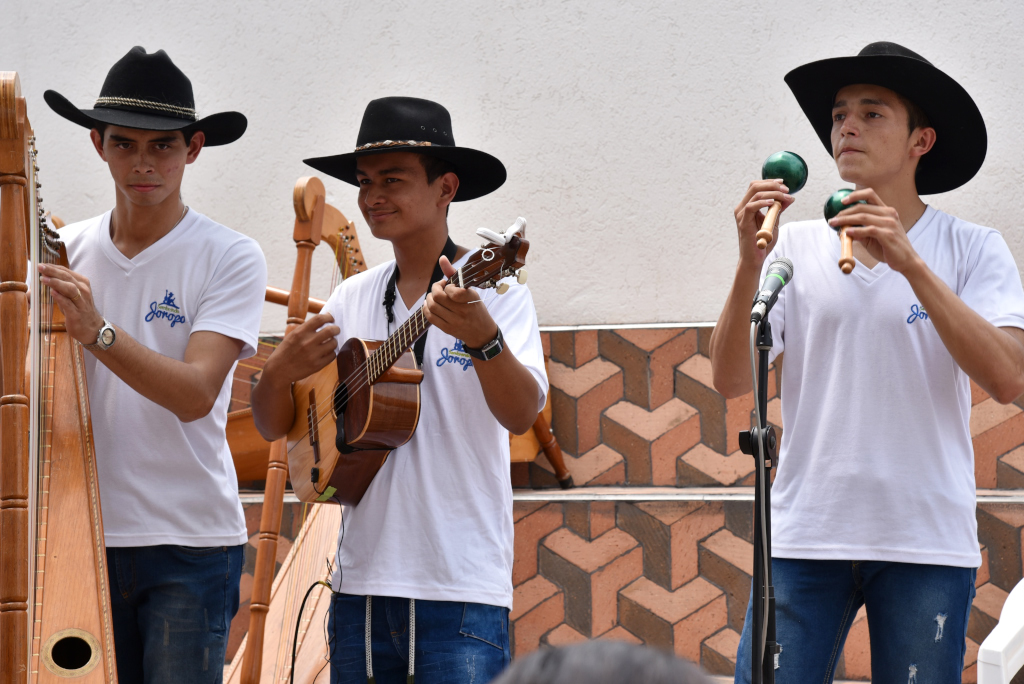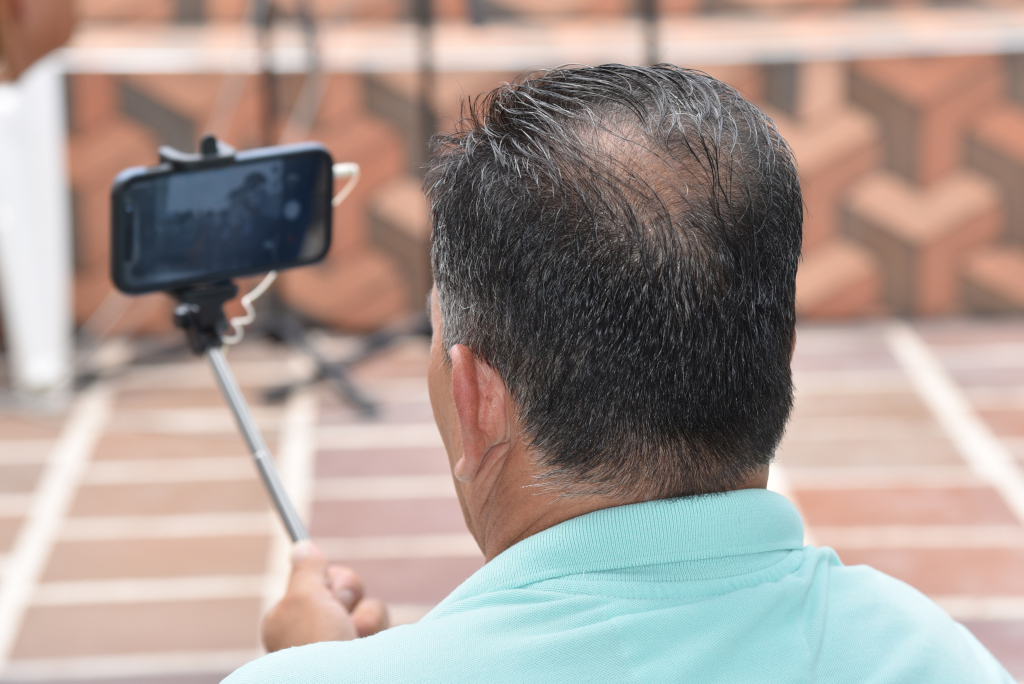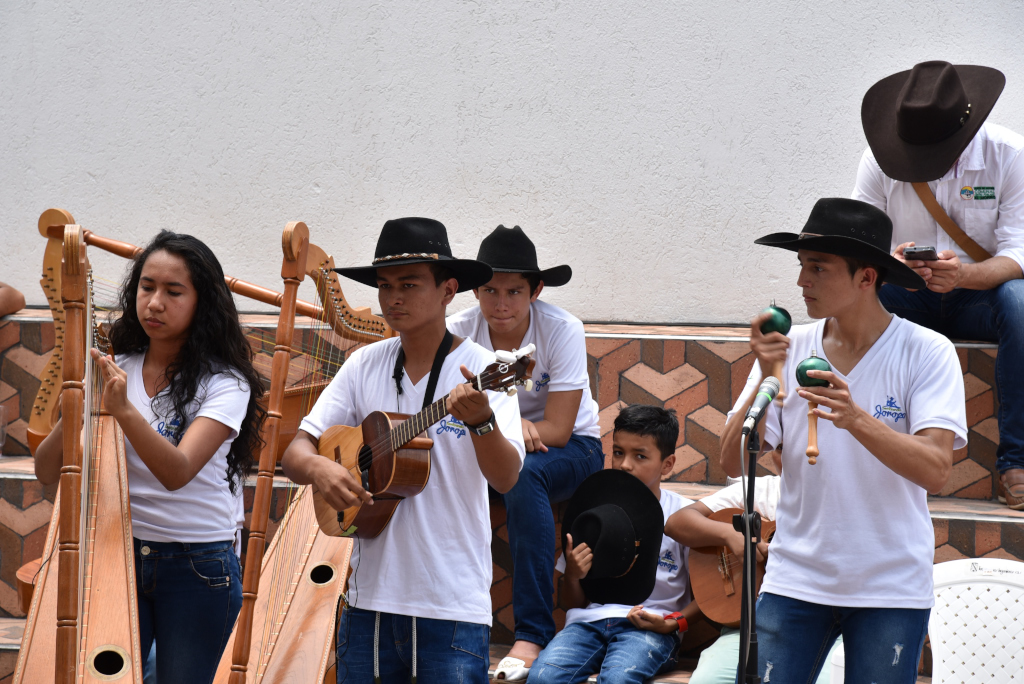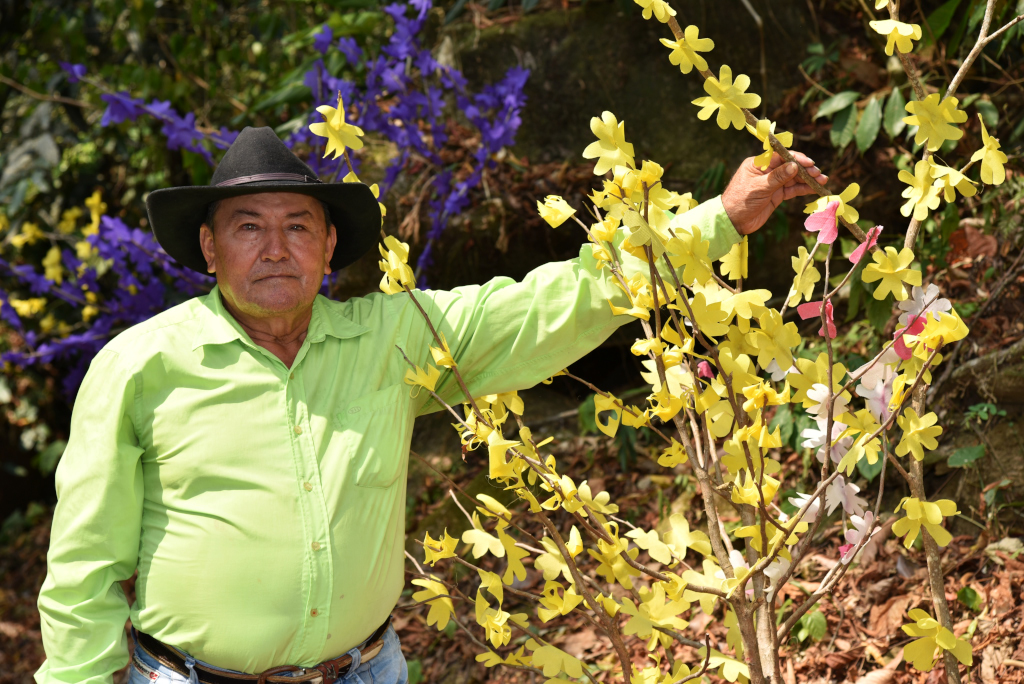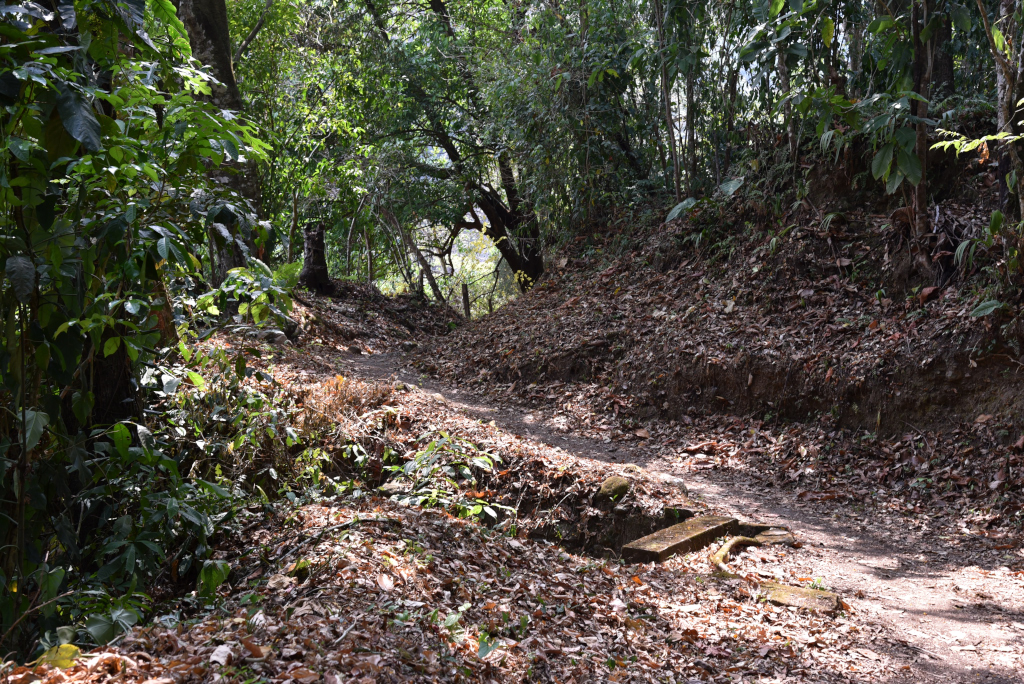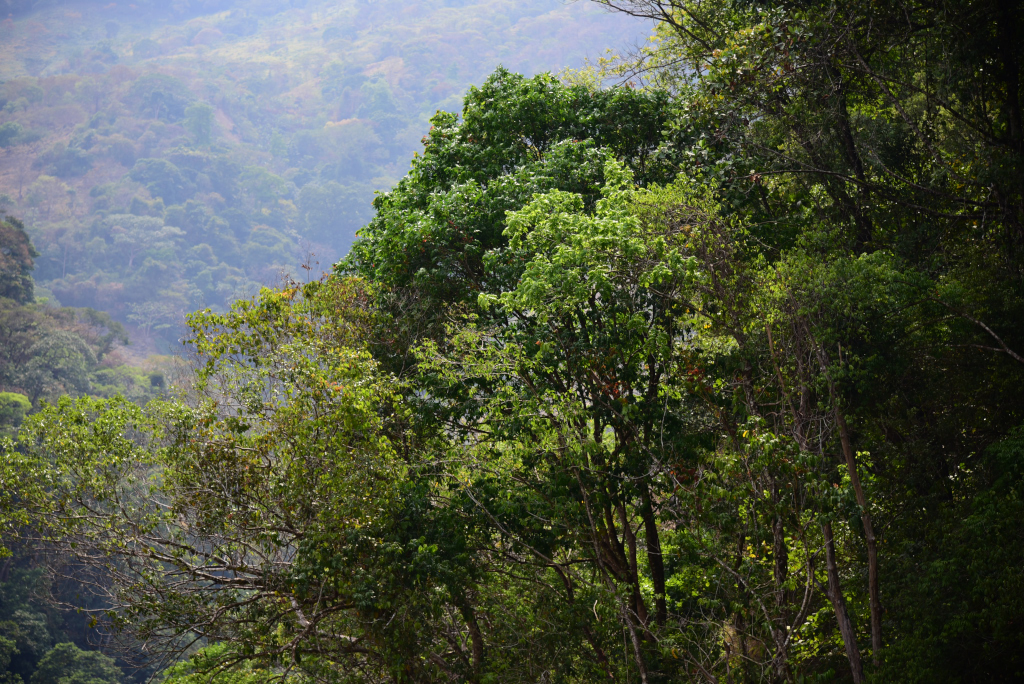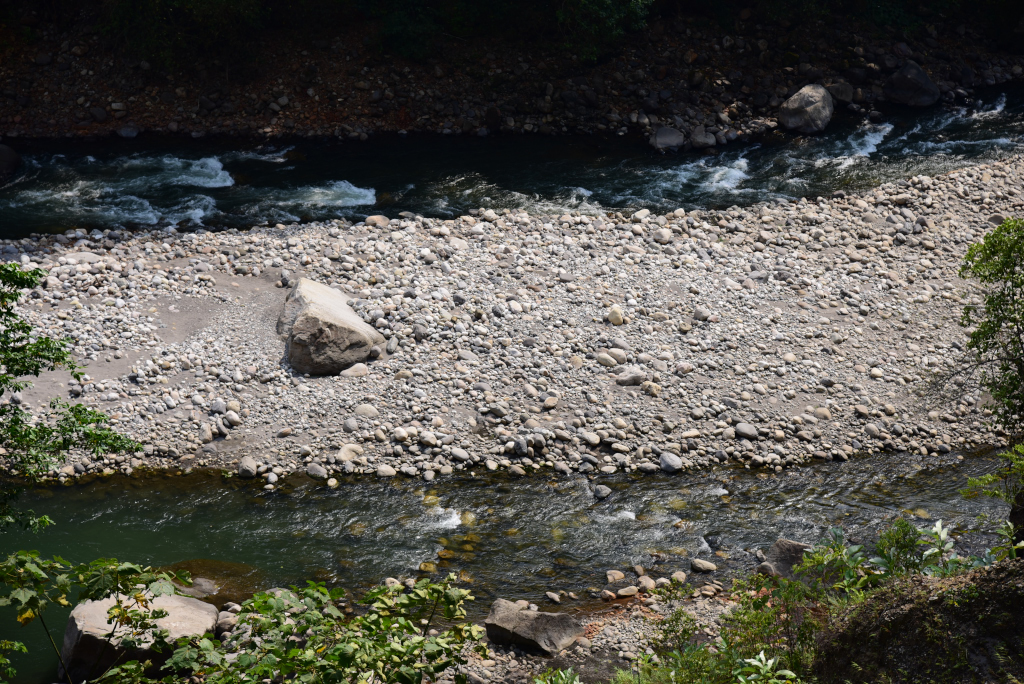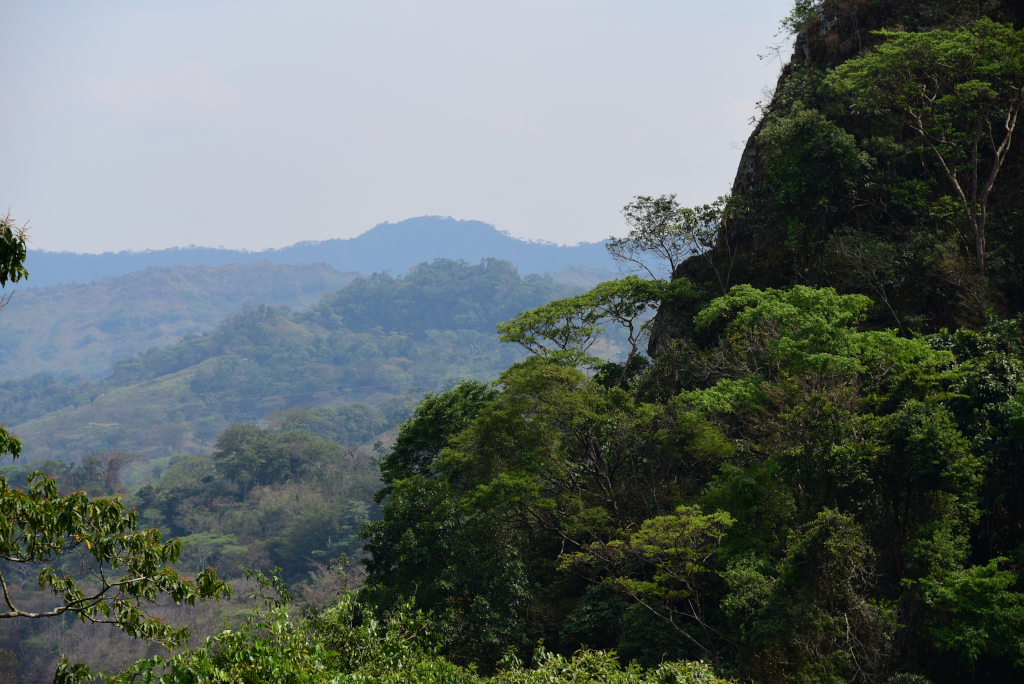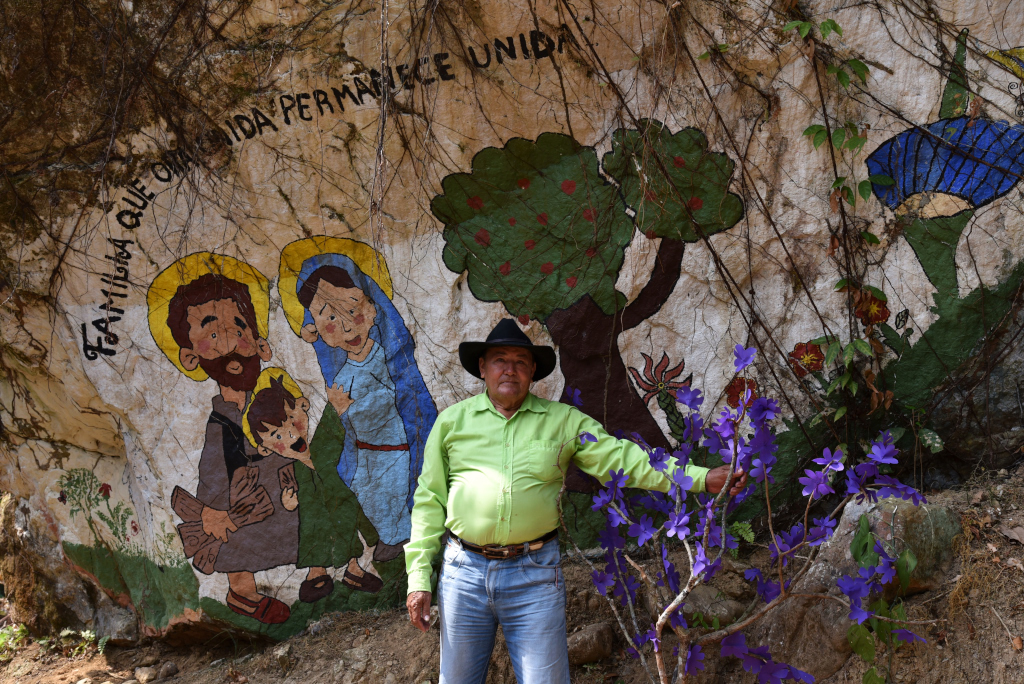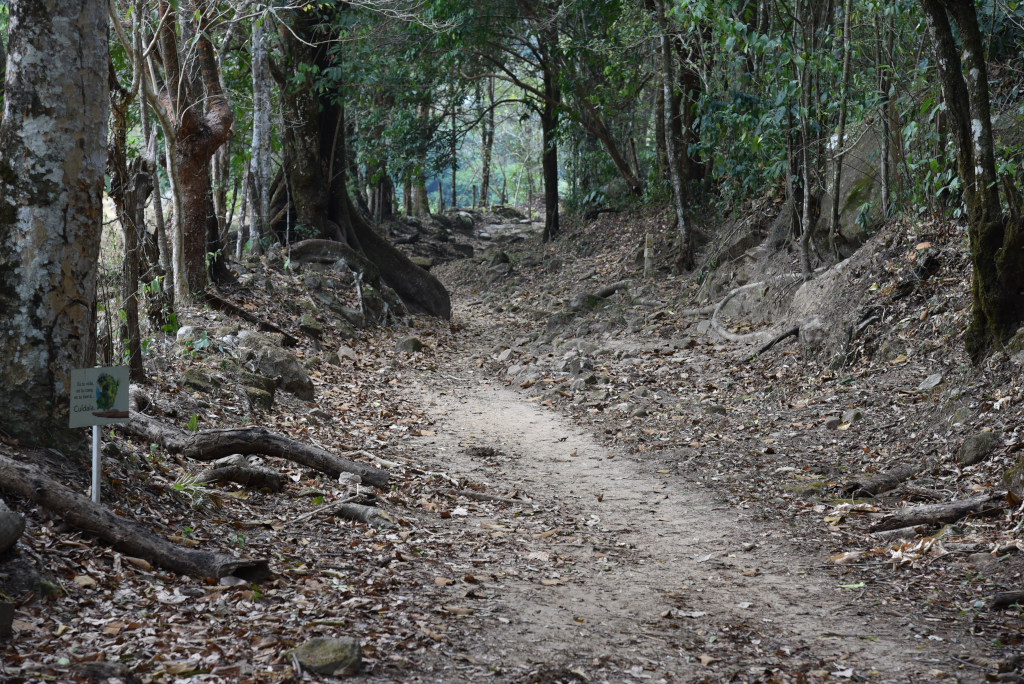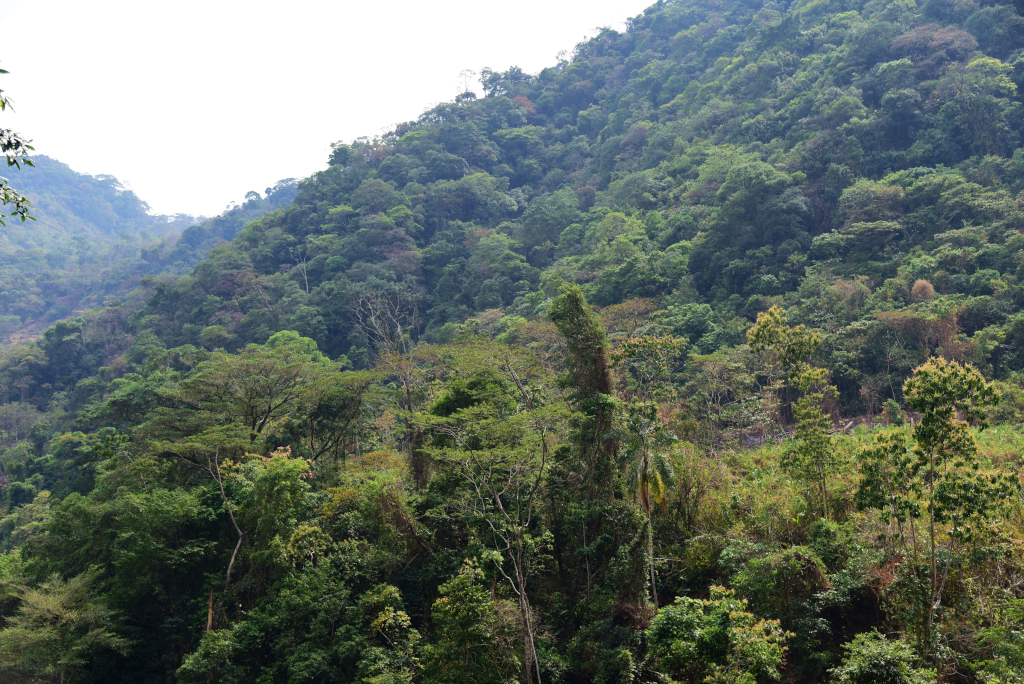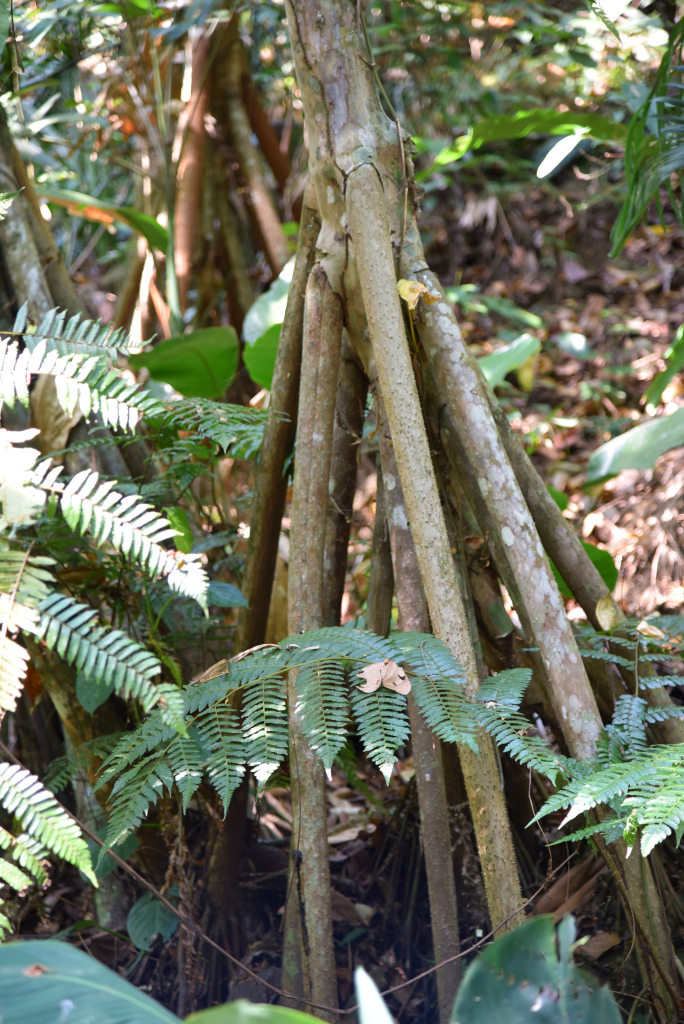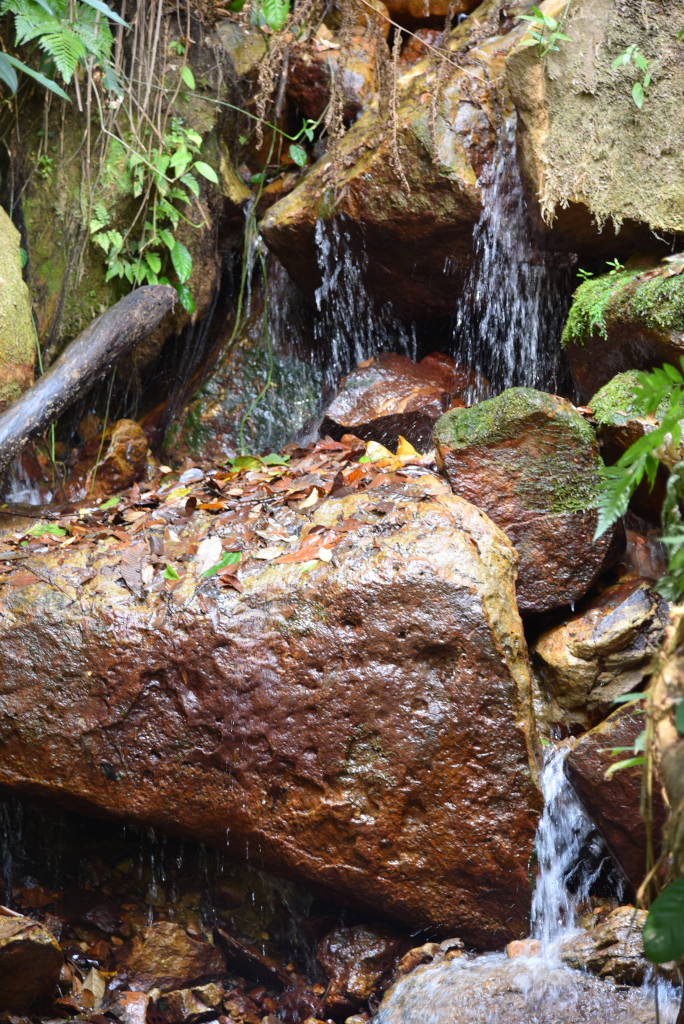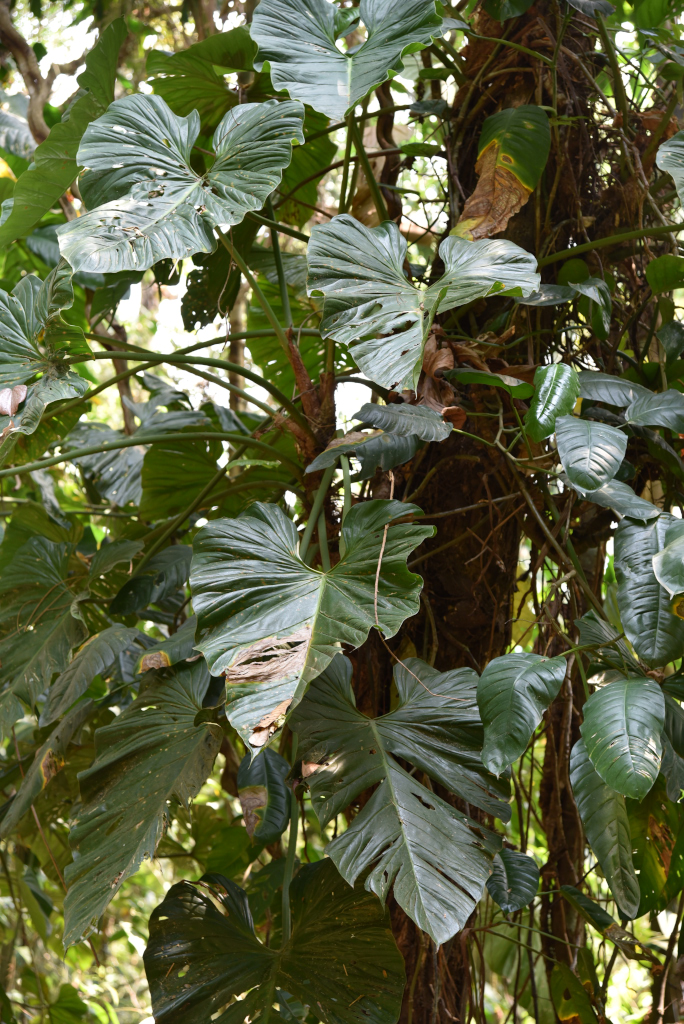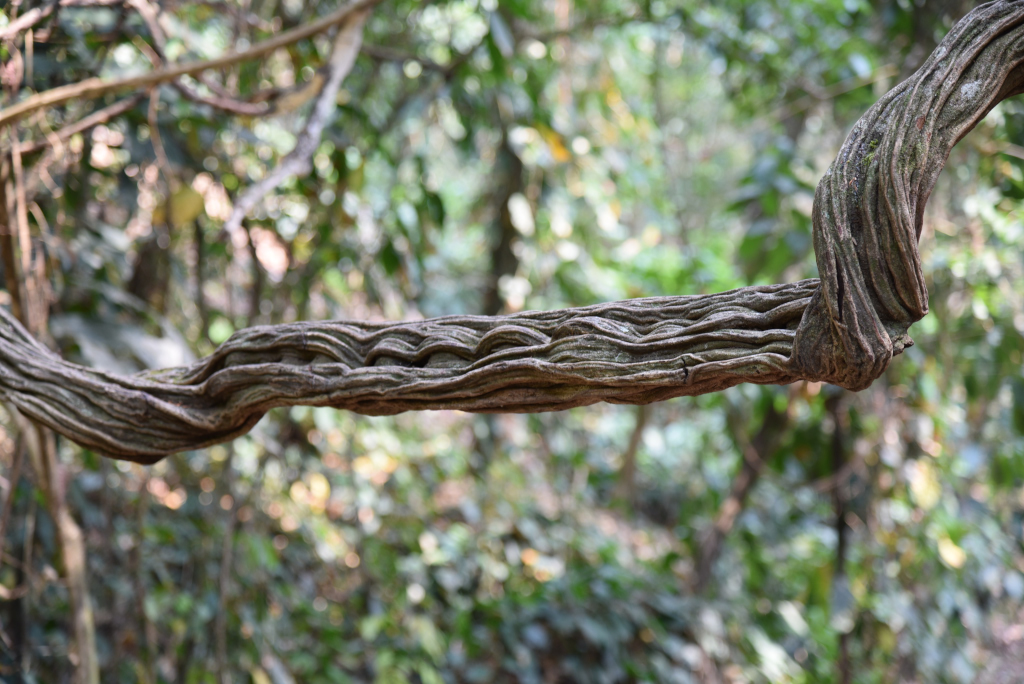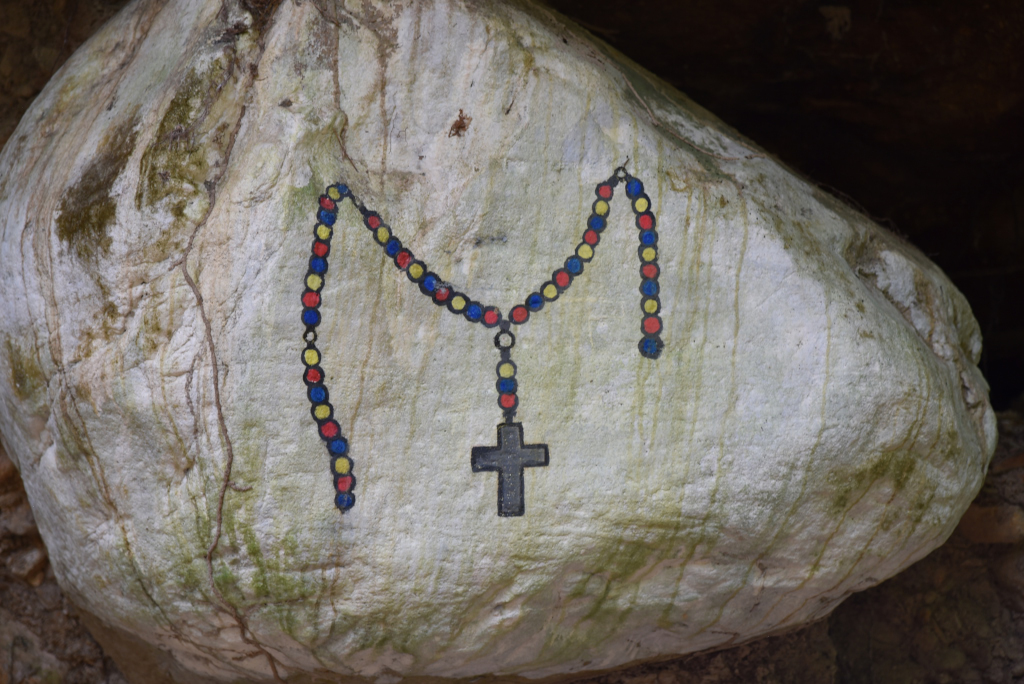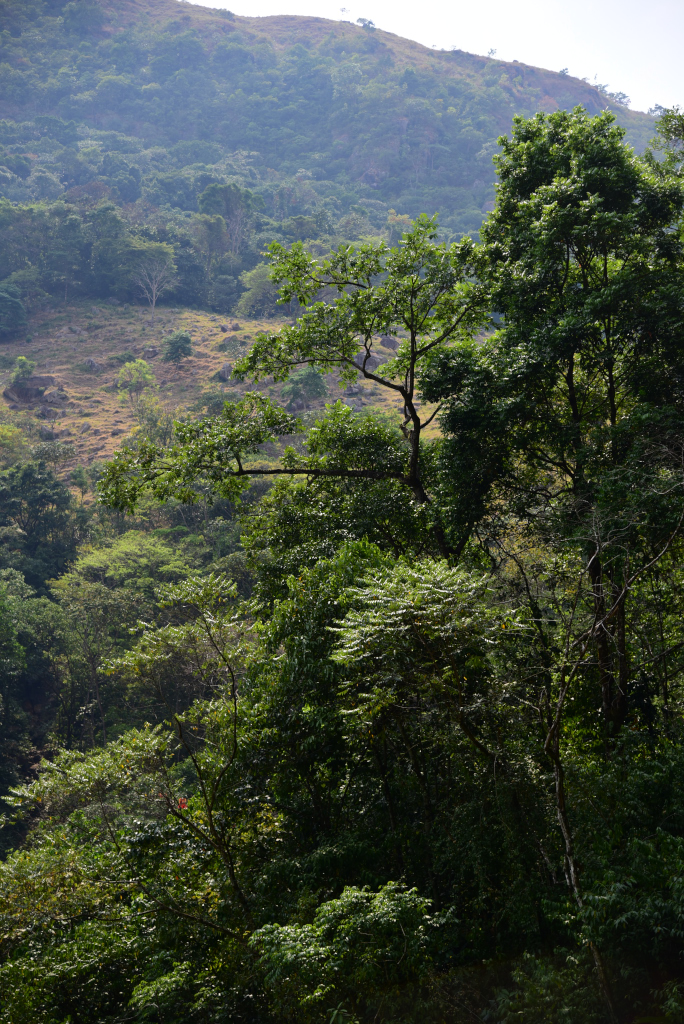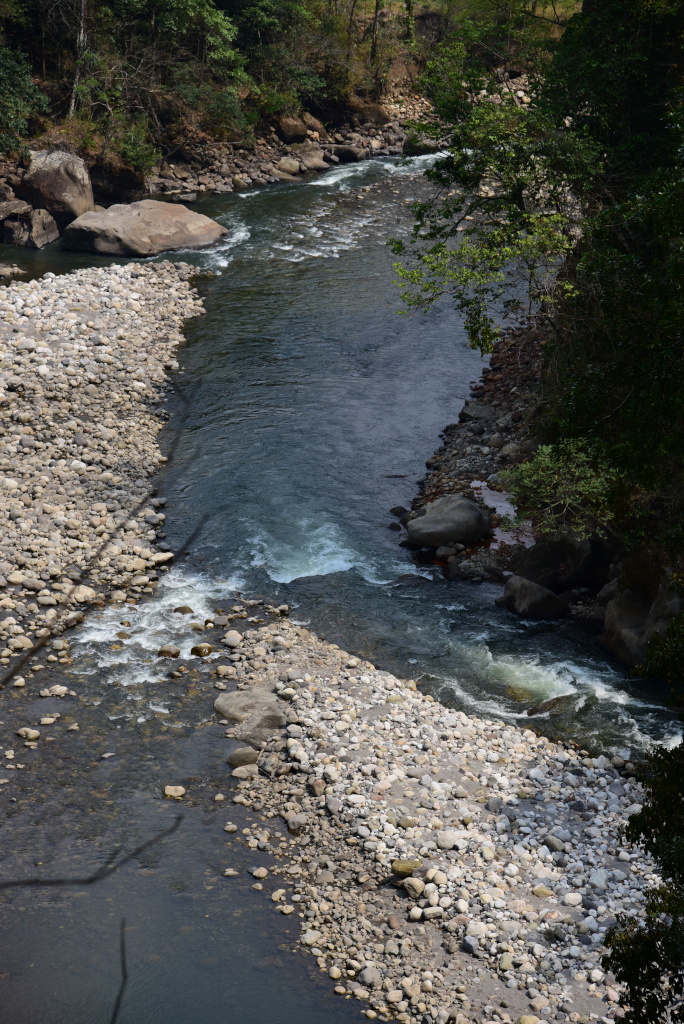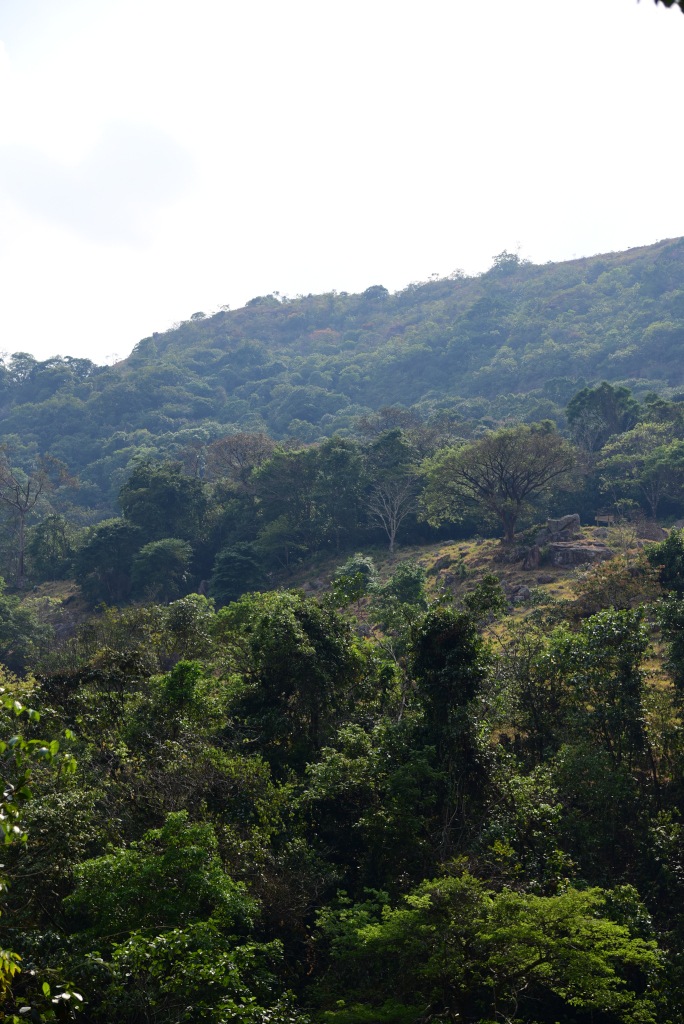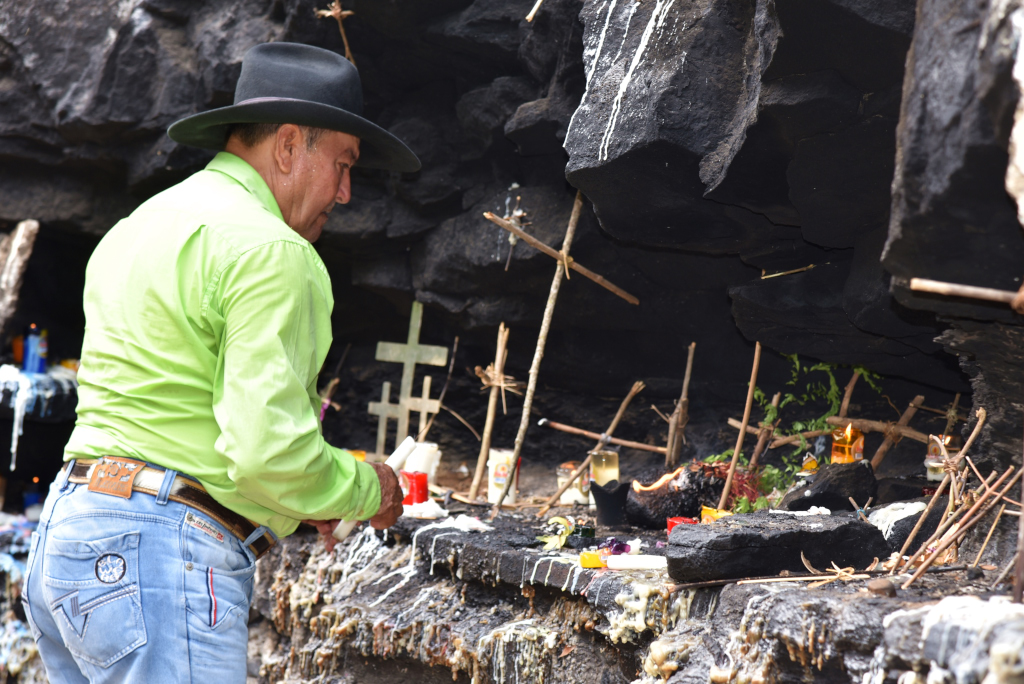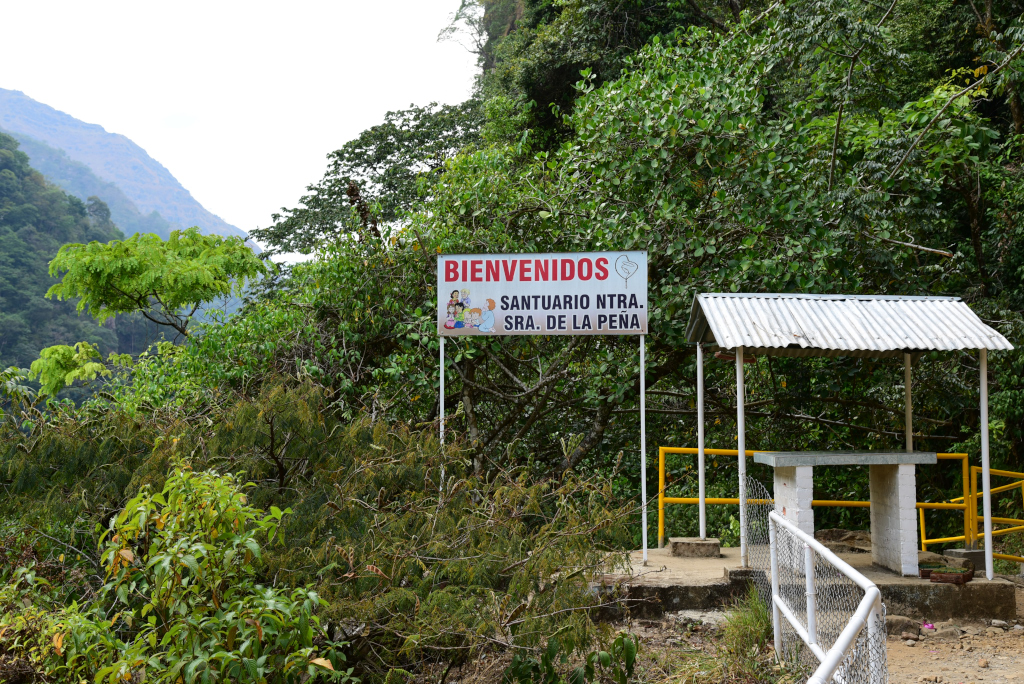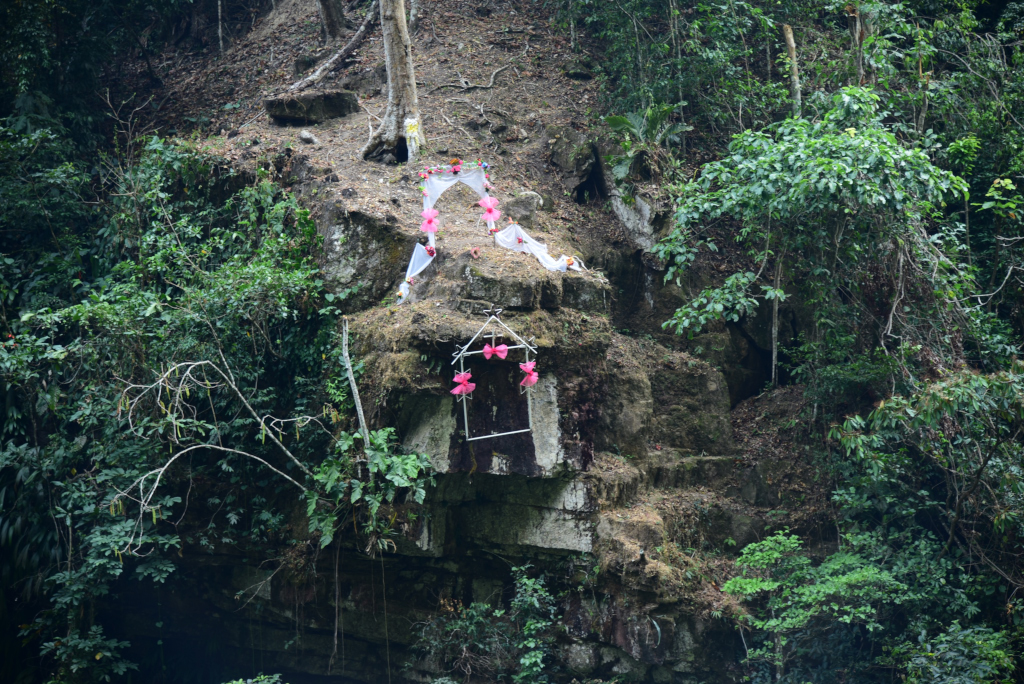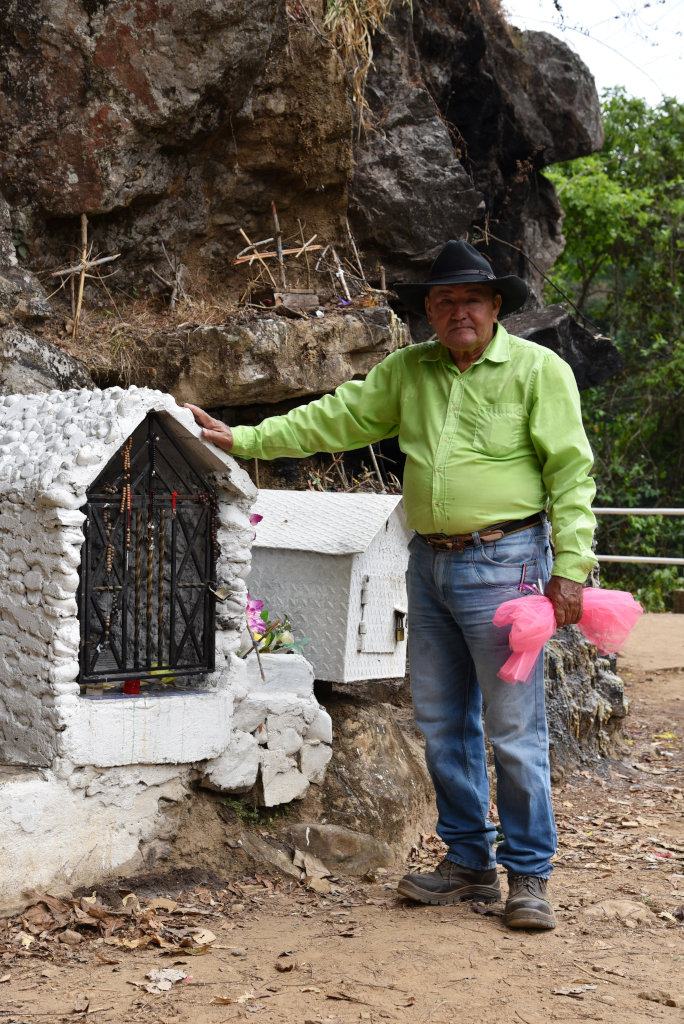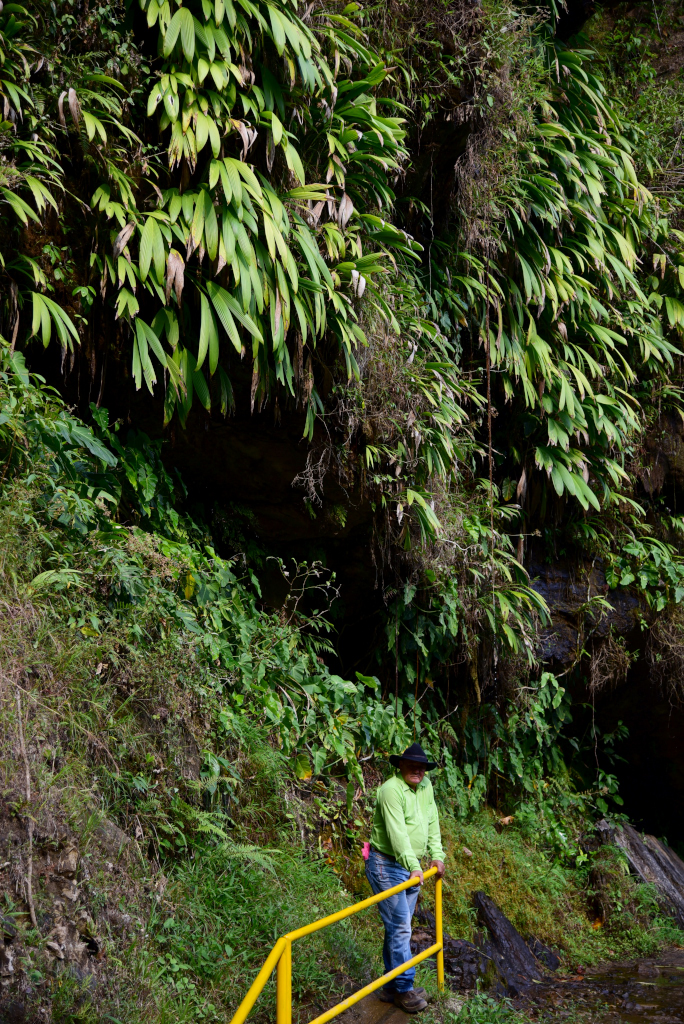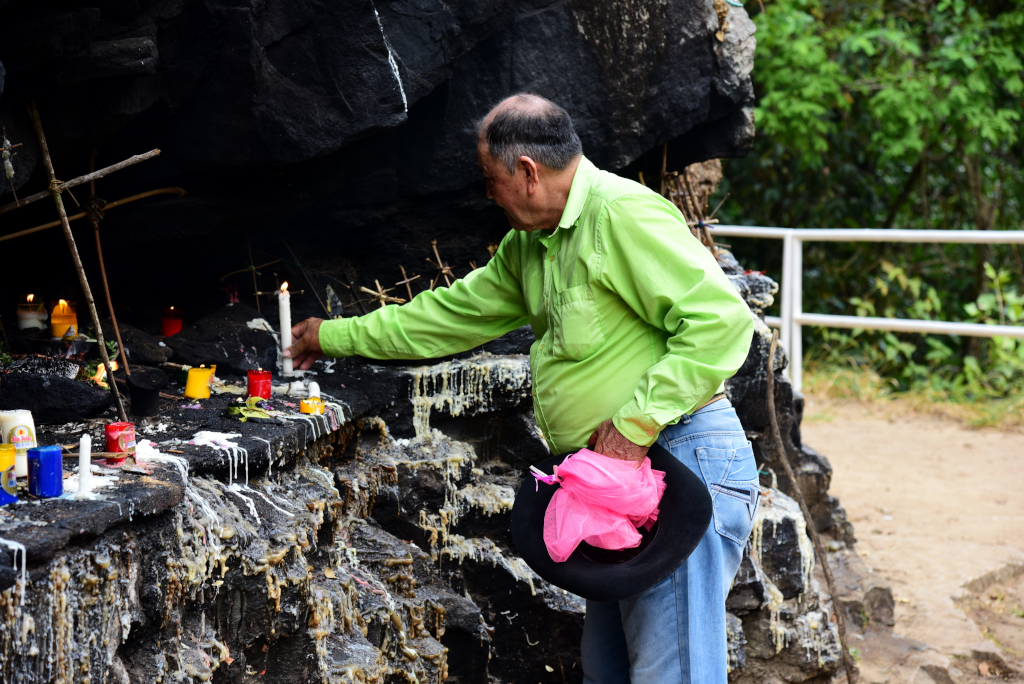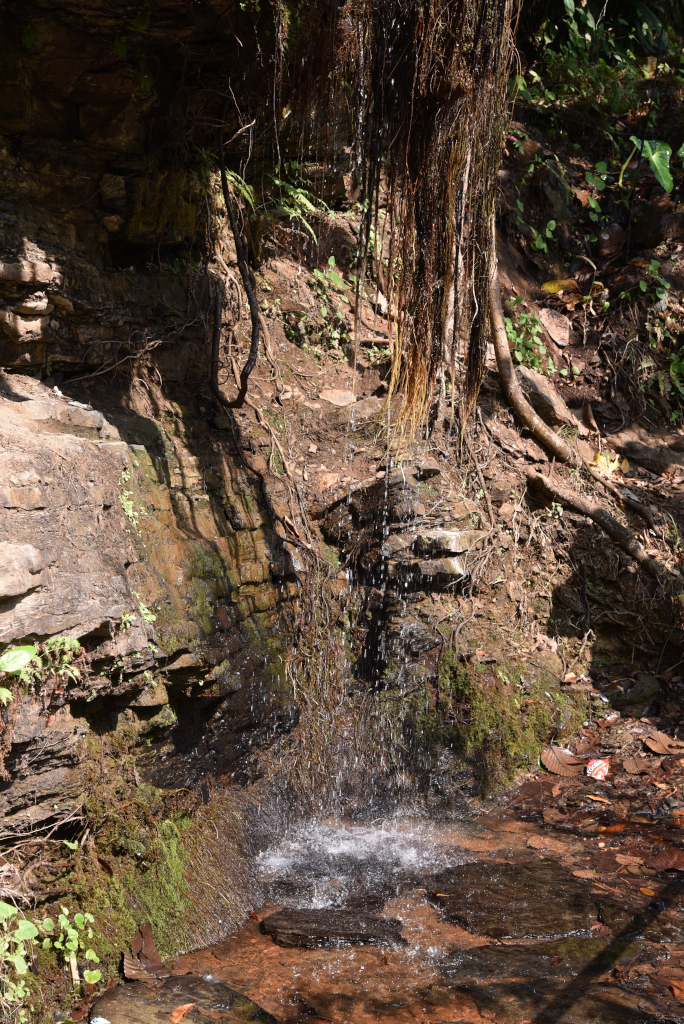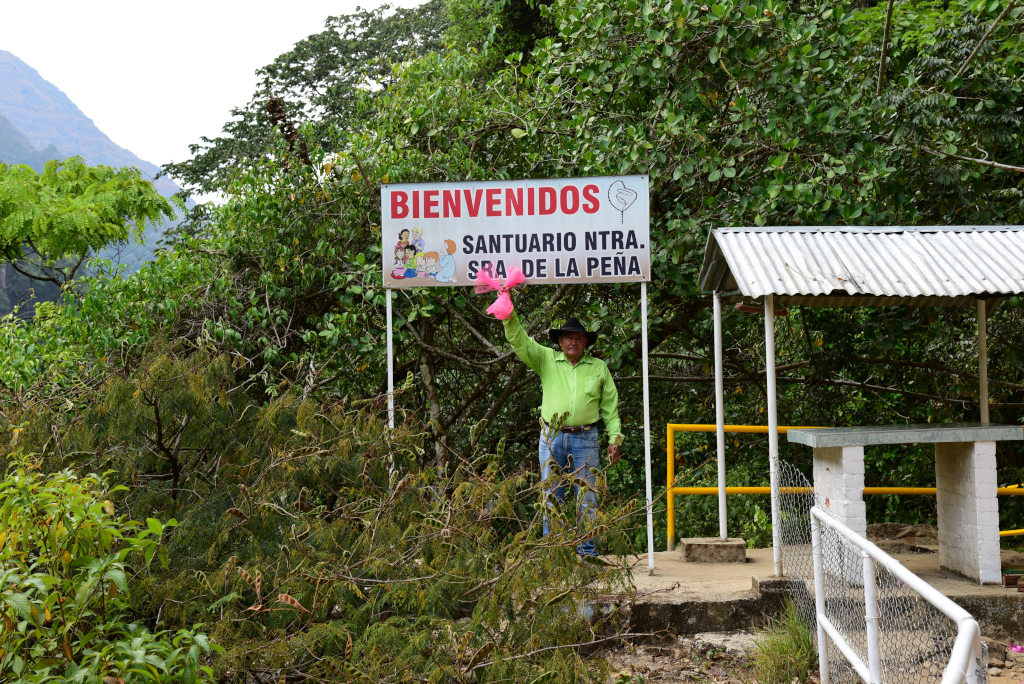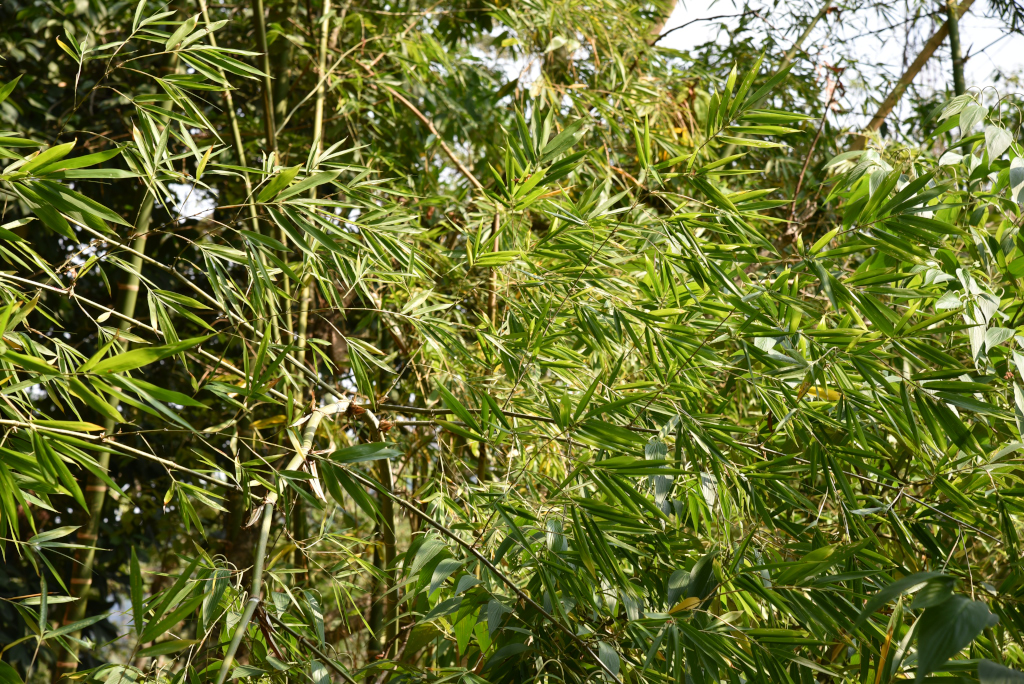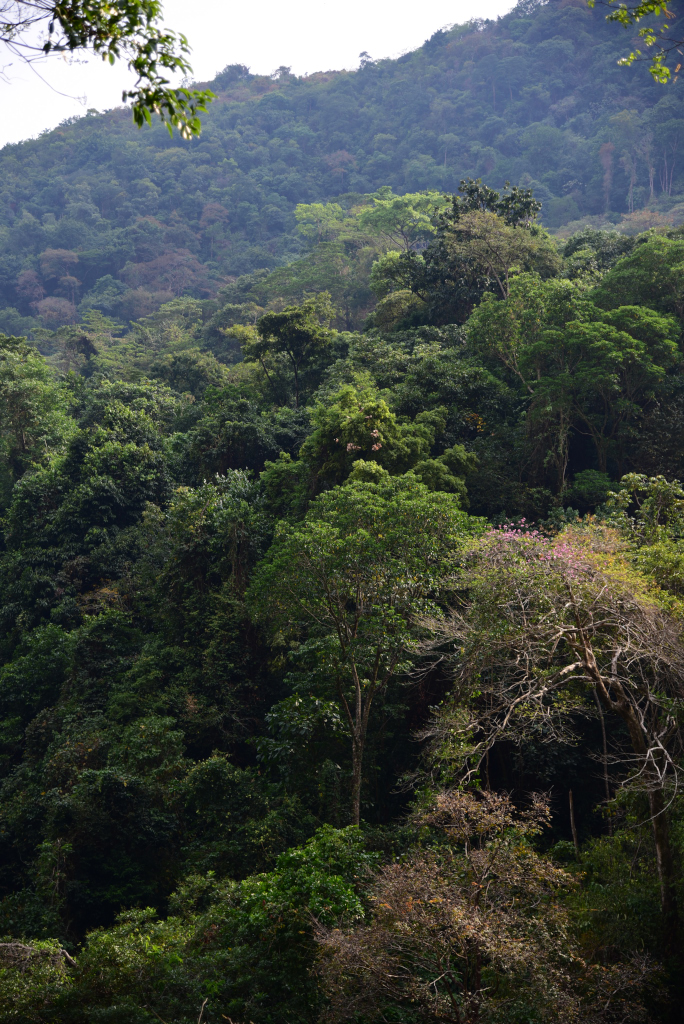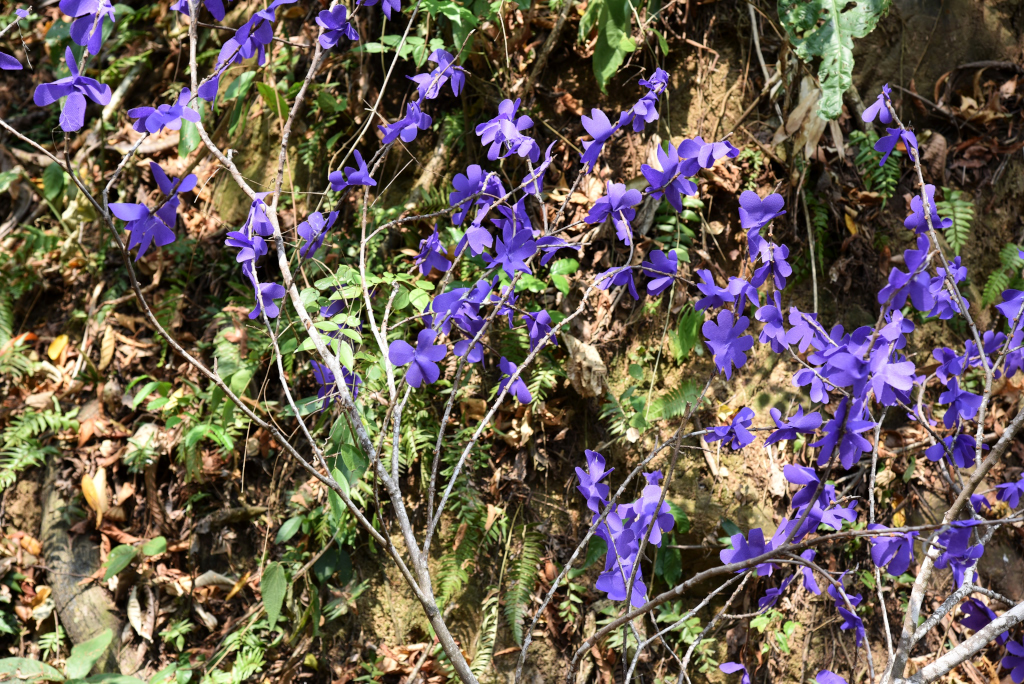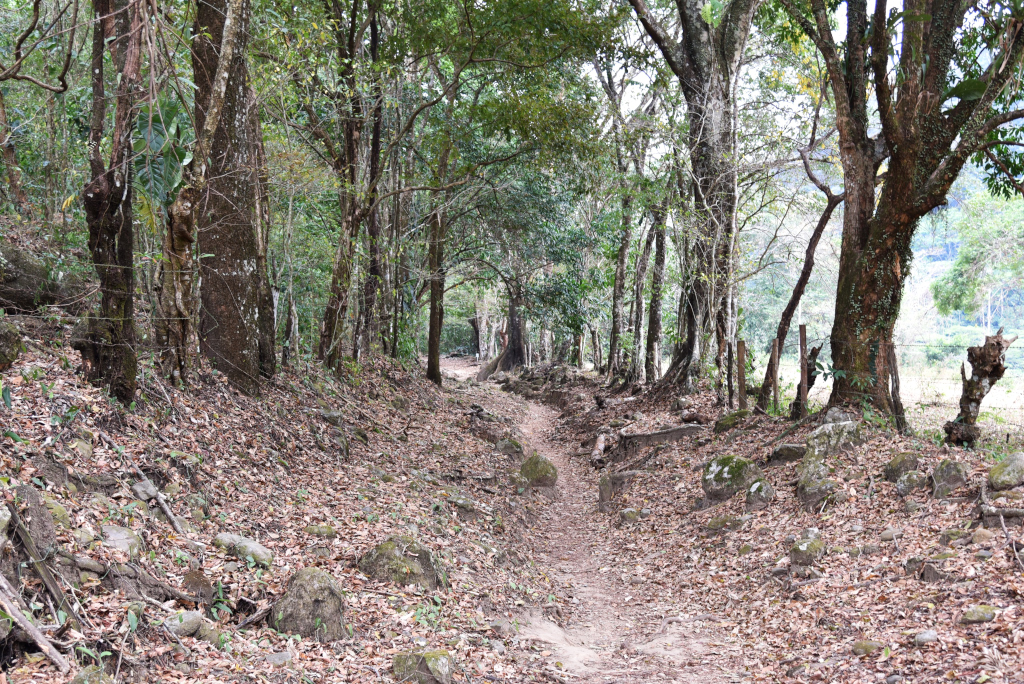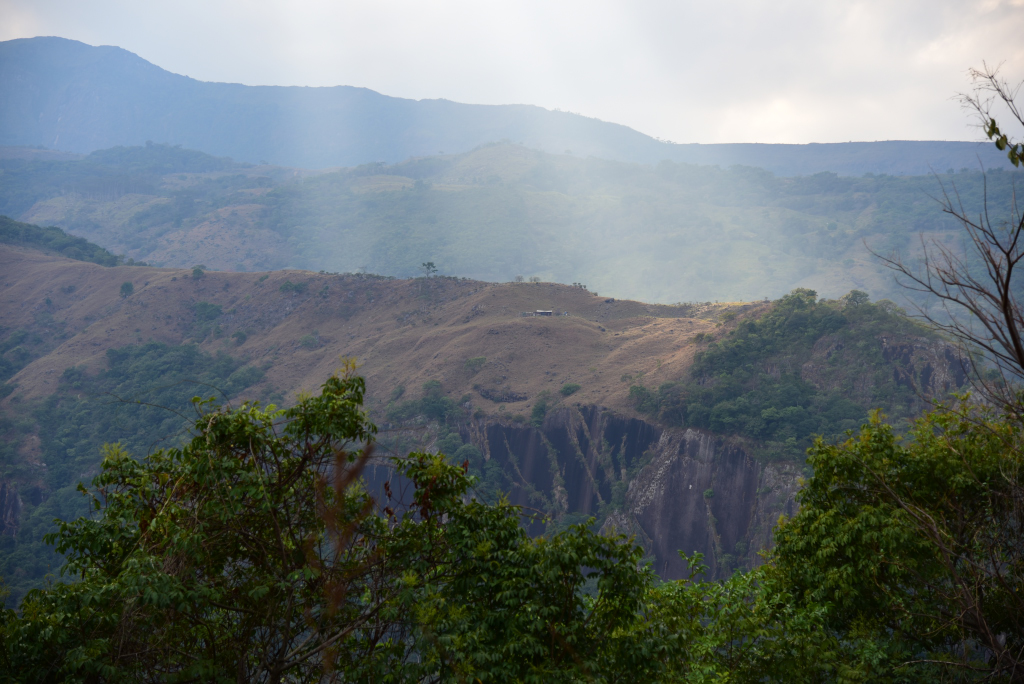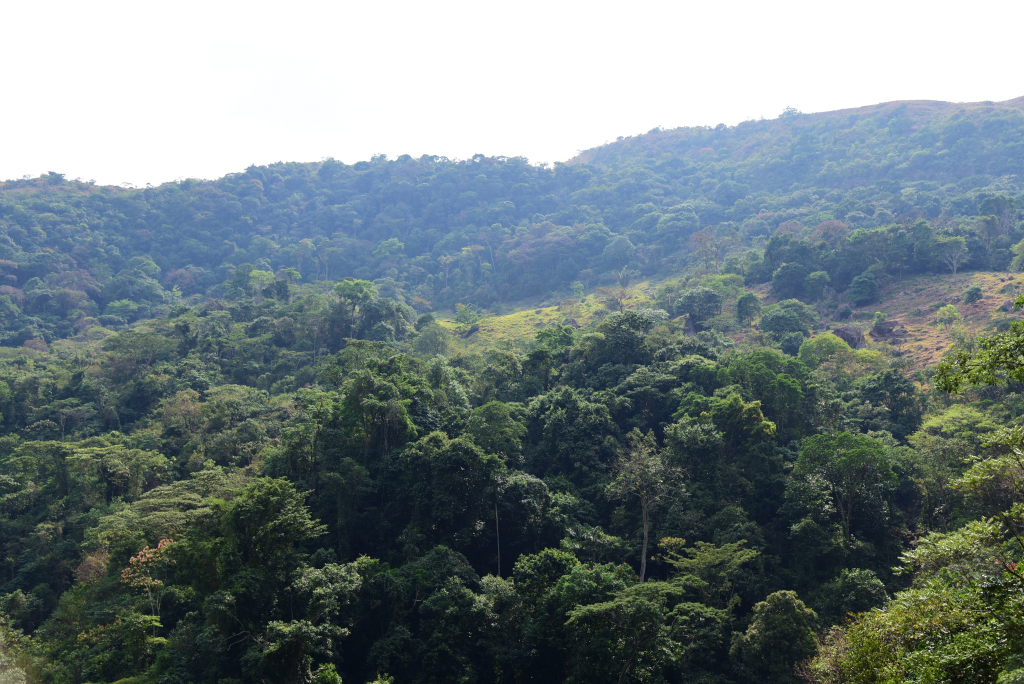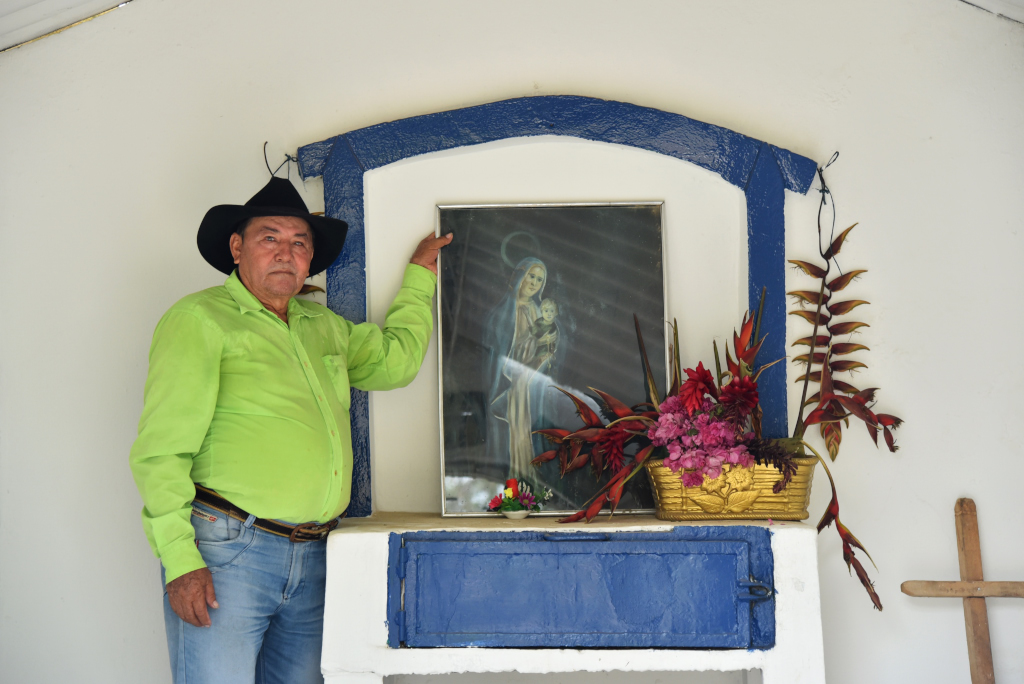March 3, 2018
My hastily assembled plan for the day will take me to the town of El Morro, close by Yopal and apparently worth seeing. A leisurely morning in my cavernous hotel room overlooking the northeastern fringes of town, followed by a copious breakfast in what will become my favorite morning haunt, the place on Calle 11 with the cavernous interior, clean, and with an ample and tasty menu of the typical morning staples, caldo de costilla and whatnot, but all very well executed. Then the transport to El Morro is apparently provided by busetas that run out of the rough pocket a block to the north of the hotel, alongside the highway.
The road weaves up above Yopal along the scenic rio Cravo Sur that runs through Yopal itself; as we rise, the landscape becomes more scenic. The llanero identity defines itself in terms of the broad sweltering plains to the southeast of the capital city, although in reality, the bulk of the population lives in the cooler, subtropical hillsides of the so-called Monte Llanero, rising up to the eventual highlands of Boyacá. In fact, beyond El Morro, the road eventually rejoins the highway to Sogamoso, not far to the east of Aquitania.
The rushing stream running alongside the meandering road climbing higher and higher into the hillsides sets the stage for the town of El Morro, however small and modest an affair it may be. Descending from the buseta at the rambling main square, the town appears quite shambolic, but it has a very friendly air, the fecund environment around the town apparent even at the centre. Unsure as to how to proceed, the group of young locals clustered in front of the town hall in costumes becomes an automatic draw. What are they dressed for? It turns out they are participating in the opening of the local Casa de Cultura – perhaps I would want to attend?
Do I want to attend? What else would I want to be doing in El Morro today? And what incredible luck I have to be in attendance for this event. Apparently, a number of local musical groups will be presenting the traditional joropo music to the gathering public, the celebration attended by locals, officials, cultural attachés, musicians, and so on. But who do I speak to so that I can be invited? I am quickly handed over to a somewhat officious woman in the obligatory blue jeans and white shirt barely cloaking her well-endowed body.
For a while it seems uncertain as to whether this event will actually transpire. We wait, wait longer, and finally, the troops are commandeered into several vehicles, and I am chauffeured with several official-looking locals and a stack of musical instruments at the back of the pickup along several muddy roads into the periphery of the town, stopping in front of a brand new, modern-looking complex that soars over the surrounding rambling residential structures, a crowd of expectant locals already gathered in front. It quickly becomes apparent that this is not a minor event – the cultural centre is intended to be a showcase in the region, and a lot of attention is being focused on the event, never mind the fact that a lot of musicians are gathering for the purpose of playing one of the country’s most incredible musical forms, joropo.
Again, the beginning of the event is delayed, the crowd growing increasingly large, jockeying for the best position both in the interior hall as well as along the periphery of the building, focusing on the courtyard at the back, where the musicians are to play. I try to stay as innocuous as possible, but the idea that a foreigner who may even be a journalist could be in attendance is drawing a lot of attention, particularly from the ever-curious younger crowd.
The young people aren’t just here to watch the event – they are in fact the musicians that will be playing, as the celebration emphasizes the schooling in local music traditions to be imparted on the next generation. The long rambling formalities and officiousness entirely predictable in a Latin environment ensue; at least I am sitting down, and it is not too hot.
At the back of the patio, a group of very young male musicians coalesces, in whose hands are assembled a variety of stringed instruments, the front row small, guitar-like instruments, and at the back, a row of enormous harps. It seems extraordinary that a country for which the likes of salsa and cumbia would seem essential, one of the most emblematic musical instruments in the country is in fact the harp, an integral piece in the hypnotic, frenetic, and deeply beautiful music known as joropo. And the young age of the assembled musicians is entirely deceptive – these children are both incredibly talented and skilled, issuing stunning renditions of typical joropo melodies.
Excerpted from Wikipedia: “Joropo originates in festivals in which the waltz and vueltiao were danced, which later led to the joropo. The term referred to a family party animated by music, singing and dancing aligned with the pitanza. Joropo possibly originates from the Arabic xarop, which means ‘syrup’. Some musicologists point to the Caribbean indigenous etymology, others to a Quechua origin. In the department of Casanare it is said that the natives of the region gave rise to the word by shouting ‘Joropo’, ‘joropo’, ‘more joropo’ when they were partying.
Until the 1950s, in the plains of Arauca, joropo instruments included the bandolin (mandolin similar to the Andean requinto), cuatro and maracas, while in Casanare, it was played with a pair of tiples (bandolón and guitarro). In the Meta, the instrumentation consisted of the tiple and bandola. To an extent these stringed instruments have been supplanted by the harp, introduced in the 1960s by the Araucan composer David Parales Bello and Luis Ariel Rey of Villavicencio. The instruments used for joropo are shared by the Venezuelan llanera culture, and draw their origin from Spain. Some of the instruments used in joropo – as is the case with other traditional Colombian stringed instruments – are used exclusively in Colombia and Venezuela.
The rapid strumming of the harp or the mandolin create the hypnotic, high-pitched rhythmic backdrop intended to recall the galloping of horses across the llanos. The harp is a diatonic instrument with 30 or 33 metallic cords, with its unique sonority. The bandola llanera originally had four strings, two of nylon, and two metal, producing lower tones, however, as with other stringed instruments, frets have been added to the bandolas over time to reflect the increased technical ability of musicians.
Traditionally four strings only, the cuatro originated in Spain and is used as accompaniment throughout Latin America, although cuatros are tuned differently in each region. Modern cuatros come a variety of sizes and shapes, and number of strings. Cuatros can either have single strings, like a guitar, or double- or triple-coursed strings like a mandolin, varying in size from a large mandolin or small guitar, to the size of a full-size guitar.
Maracas made typically of gourd provide an understated percussive backdrop, interesting inasmuch as the extremely rapid pizzicato playing of the stringed instruments which drives the sound is itself percussive in nature. Despite the simple appearance of the instrument and its playing, it requires a substantial amount of technique, whereby each hand is often executing a movement independent of the other.”
The young musicians fly through a stunning repertoire of music, the exclusively acoustic stringed instruments strummed rapidly and others plucked with enormous speed and precision to produce the classic melodies. The only electric instrument that supplements the mix is a bass, barely audible in the onslaught of bright strings. The young men are dressed uniformly in blue jeans, baggy white T-shirts and black felt cowboy hats, not surprisingly, given that the music they are playing is Colombian cowboy music. Country music never sounded this good!
Following the live music session, the young musicians disband, and are replaced by a troop of young dancers performing in couples, the girls wearing floral adornments in their tied-up black hair, knee-length, pleated dresses that twirl widely as they cavort back and forth to the joropo music’s quick rhythms, the boys in white shirts, long black pants, not to forget the black felt cowboy hats. The gyrating acrobatics of the dancing are almost comical, given how young the children are, but the degree of talent and commitment is indisputable. The love for their identity and pride in their culture is evident in even the youngest of the joyful participants.
Sadly, the dancing is not backed up by the children’s orchestra, rather, recorded music, especially given that the young people are such good musicians. Given that I just chanced on such a spectacular event on a side trip to a small town in the region, I wonder how many such centres of traditional music there are in Casanare? Given what I am experiencing today, I can only imagine that the musical tradition must be very well-represented in the region. I am told that the Casa de Cultura was funded in cooperation between the committee to create the casa and industry, and that the local municipal government was of no assistance.
The next group of dancers is older, probably in their mid-teens, less innocent than their younger peers but more sensual in their roles, the boys preening and girls exotic and well-endowed. The dress is somewhat different, the young men wearing baggy white shirts and pants, over which are draped loose black cowls, with blue bandanas around their necks, and topped with smaller black fedora hats. The young women wear layered short-sleeve blouses with sashes bound around their waists and hair tied with long, multi-coloured ribbons. The young men and women alternate between dancing as couples and in group formation. The men grin provocatively, some obviously finding the whole experience very funny, while the women hold their heads high, proud, radiant and beautiful.
The ensemble finishes, and now we are presented with a finale of live music played by a somewhat smaller ensemble of young musicians, more experienced, focused, in no way less powerful than the music we heard earlier only. In addition to the electric bass player, there are two harp players, a cuatro (I believe) and a maraca player. These musicians are not as young as the ones who played earlier, and are much more intent on their work.
Now on to the next stage of the celebration – lunch. The hordes of musicians, officials and audience at large troop into an adjoining hall where an enormous banquet has been set up, dozens of long tables covered in white table cloths, attended to by costumed waiters who eventually bring plates of classic Colombian fare to the table, heavy on starches and fatty meats, but who am I am to complain. Now I am definitively in the centre of attention, the brasher boys clustering around me, peppering me with questions, the more timid youth keeping their distance, but intensely curious as to my presence at this event. Needless to say, this is not the kind of event that attracts foreign tourists, given that that tourists are already barely visible in the region.
The cacophony continues, the feral children shouting and cavorting wildly, and despite repeated admonition on the part of the elders, continuously approaching me with more questions, repeatedly taking photos with me, until we begin eating, which becomes another major endeavour, given how heavy the food is and how hot it is. I am sensitive to the idea of not clearing my plate, given that there are enough people around me who probably can’t afford to eat so well on a regular basis. The ostentatious lunch finally comes to an end, the officials dissipating, and I am now left wondering how I can address the question I had earlier on upon arriving in El Morro, namely, how to get to the Santuario Virgen de la Peña, which is the big attraction of the town.
It turns out that my questions earlier on were not being ignored, and that the corpulent, middle-aged man wearing the broad-brimmed cowboy hat at the lunch is intended to be my guide to the sanctuary. I really would love to do this on my own, without the assistance of a guide, but that would be predicated on the path being straightforward enough to the sanctuary, and the idea that the trip is safe enough. Here, as in many other places in the country, the appearance of the environment may seem very innocent, but one should not be using that to make assumptions as to how safe it really is.
Some 80 years ago, an image of the virgin appeared in the place of the Santuario Virgen de la Peña, which subsequently became one of the prime pilgrimage destinations of local Catholics, particularly on holidays. Luckily, my guide and I are the only people on the trail, although normally this could also imply vulnerability to banditry. In any case, the winding trail begins in a well-defined manner, the broad, relatively flat and easily navigable path flanked by stately trees, but soon narrowing and becoming more serpentine, and bathed in deep mud from the numerous small waterfalls and creeks that pass through the terrain.
The spectacular and verdant mountainous landscape rises around us, rich, green and luxuriant. This certainly is very different from the relatively barren land you see in Boyacá further to the north, where the only evidence of forest seems to be scraggly eucalyptus trees. The apparent excess weight of my guide in no way seems to prevent him from nimbly clambering along the muddy trail; he is easily far ahead of me already at the outset, not that continually removing the oversized camera from my bag and having to take that perfect shot is making matters proceed any faster.
I could obviously have come here on my own, given that the trail is hardly that obscure, but what the heck. My guide is also intent on having his photos taken, and I am OK with that as well. While the bulk of visitors come here to visit the sanctuary, which they consider sacred, I am just happy to take in the gorgeous subtropical forest around me. We can’t delay too long at the sanctuary, and need to make our way back to town, as the light is getting low. En route I conveniently slide in the mud and fall heavily into a pool of water, which my camera is lucky to survive intact from. At least the camera was in my backpack; while I tend to almost always hold the camera in my hand so I can shoot at a moment’s notice, there is also a far greater risk of tripping, and losing another very expensive camera.
Back in the small town centre, I see familiar faces from the gathering at the Casa de Cultura on the street. While the gathering at the cultural centre was very impressive, the town itself does not look very wealthy. Rito and I sip our well-earned Nescafe while he describes his financial plight, the years not having made life easier here. The place used to be wealthier when the price of oil was higher, and the enormous drop in price has cost the region dearly. He is hesitant when I ask him how much to pay him for the guiding effort, but his dour demeanour brightens substantially when I offer him far more than he expected. Given the financial circumstances he has described, he certainly needs all the help he can get.
Into the buseta for Yopal waiting at the parquet, and then I am off again, back to the now familiar reality of Yopal, which is a huge city compared to El Morro. The extensive tracts of the exposed rio Cravo Sur running down towards the plains certainly look very inviting at this point; I would love to get off and spend several hours wading in the cool refreshing water. While the road passes immediately along the river and the busetas are normally quite frequent, the service cuts off at 5 or 6 pm, as is the case with regional bus service in much of the country, and I am on one of the last buses back to town. So, maybe on another day …
Just north of the parque, I find a juice shop offering fresh juices, perfect for rehydrating following this – I would like to say exhausting – day, but only so because I am so heat-intolerant. Sitting at one of the tables on the street, who do I see but the director of the agency that organized the opening event I attended in El Morro. I am the image of enthusiasm, congratulating him on the fantastic effort, although my over-the-top description of the possibilities of tourism in the region probably becomes annoying after a while …
Down to practicalities as the day nears its completion. I would love to finally go to the gym, but have to be in bed by 9 pm, considering that I am expected to be up at 4 am to go on the safari into the bush that I organized yesterday. I am serious doubtful about the value of getting up so early, but such are the requirements of the excursion. And I am beginning to get seriously upset with AirBnB, given that in my third attempt to book a place in Bogotá, the property owner has indicated that the address of the property is not the address advertised, yet has not given me the actual address. AirBnB doesn’t seem to have any meaningful mechanism for effectively filtering dodgy property owners, nor can you get hold of the agency directly. Even if I get a full refund for next weekend’s planned stay, I will be right back to the beginning as far as having to make an alternative booking in the last moment.
Now for the last major decision of the day: where to eat dinner. I am not much of a pizza person, but even less into Colombian food. I am sure there may be great opportunities to eat throughout the town, but all I know of that is assured quality resides at the far east end of Calle 11. Mind you, much of the real estate is taken up by sports bars, the only hipper places being the Peruvian restaurant, sitting largely empty this evening, and the Cafe Napoli, where I score the last table.
I implore the waiter to infuse the pizza with as much garlic as possible, given how bland Colombians prefer their food, and with the addition of oregano powder and chili flakes to the finished product, the pizza turns out to be very good. Conversation at the table behind me is boisterous and dedicated to politics, not surprisingly, considering that the Senate and Assembly elections are taking place in a few weeks. And at this late time of evening, the few remaining outfits in operation are the political party offices.
There is nothing like coming back to my expansive hotel room and blasting the frigid AC …

